Physical Address
304 North Cardinal St.
Dorchester Center, MA 02124
The unprecedented advances in cancer genetics and genomics are rapidly affecting the clinical management of solid tumors. Molecular diagnostics are now an integral part of routine clinical management for patients with lung, colon, breast, and gynecologic malignancies among others. In sharp contrast, until recently, molecular biomarkers were noticeably absent from management algorithms for urologic malignancies, including bladder and renal cancers.
Integrated genomic analyses of bladder cancer have led to a novel molecular taxonomy of muscle-invasive carcinoma and the identification of predictive theranostic markers and elucidated new targets of therapy. Clinical trials to evaluate these strategies are finally being launched and are facilitating their adoption in routine practice.
In recent years, the detection and treatment of renal tumors has shifted toward radiologic detection of smaller lesions with an increasing tendency toward a laparoscopic approach for partial nephrectomy, ablative cryotherapy, or radiofrequency ablation. When ablative therapy is contemplated, a proper classification of renal tumors based on a needle biopsy obtained before such therapy is even more crucial, given the lack of additional sampling. The increasing number of differentially expressed renal tumor markers has been valuable in such a setting. This is especially true in light of the many emerging entities in renal neoplasia. The tremendous progress in targeted therapy for advanced renal cancer will continue to drive parallel advances in companion diagnostics.
The following is a discussion of the utility of immunohistochemical (IHC) markers, genomic applications, and prognostic aspects of bladder, renal, and testicular tumors.
In 2021, an estimated 83,730 new cases of bladder cancers (BC) will be diagnosed in the United States that may lead to 17,200 deaths. Bladder cancer is the fourth most common cancer in American males and is ranked eighth in male cancer mortality. Because of the high rate of tumor recurrence and the need for frequent cystoscopy, BC is the cancer with the highest cost per patient, with an annual burden of more than $3 billion to our health care system. Nevertheless, BC presents us with unique opportunities for early detection, given the novel applications of molecular detection methods (liquid biopsy).
Clinically, urothelial carcinoma manifests in two distinct phenotypes. The first is superficial, non–muscle invasive bladder cancer (NMIBC), which represents three-fourths of new cases. Half of these superficial tumors will recur as NMIBC tumors, and approximately 10% to 20% will progress to muscle-invasive disease. The mainstay of therapy in NMIBC is transurethral resection biopsy (TURB), with or without intravesical chemotherapy and immune therapy with bacillus Calmette-Guérin (BCG). The second phenotype is muscle invasive bladder cancer (MIBC), which represents 20% to 30% of all BC. Only 15% of muscle invasive cancers have a prior history of superficial disease (progression), whereas the majority (80% to 90%) are primary de novo tumors. Currently, patients who suffer from muscle-invasive high-grade tumors are destined to a disappointing 50% to 60% overall survival rate, despite aggressive combined treatment modalities that include cystectomy, chemotherapy, and immunotherapy.
Cytokeratins (CKs) are a family of intracytoplasmic intermediate filament proteins present in almost all epithelia. Expression of each CK molecule depends on cell type and differentiation status; therefore, specific CKs can be used as markers to identify particular types of epithelial tumors ( Table 17.1 ). CK7 is present in a wide variety of epithelia, including the columnar and glandular epithelium of the lung, cervix, and breast, as well as in the bile duct, collecting ducts of the kidney, urothelium, and mesothelium, but it is not in most gastrointestinal (GI) epithelia, hepatocytes, proximal and distal tubules of the kidney, and squamous epithelium. In contrast, CK20 shows relatively restricted expression and is present in GI epithelium, Merkel cells of the epidermis, and urothelium.
| CK7+/CK20+ | CK7−/CK20− | CK7+/CK20− | CK7−/CK20+ |
|---|---|---|---|
| Urothelial Ca Pancreatic Ca Ovarian mucinous Ca |
Hepatocellular Ca Renal cell Ca Prostatic Ca Squamous cell Ca Neuroendocrine Ca |
Urothelial Ca Breast cancer Lung non–small cell Ca Primary seminal vesicle Ca Ovarian serous Ca Mesothelioma (all forms) Endometrial adenocarcinoma |
Colorectal Ca |
CK7 expression is observed in the majority of urothelial carcinoma (UC), whereas CK20 expression in UC can vary from 15% to 97% in different studies. Bassily and colleagues showed that CK20 is more frequently positive in low-grade tumors (83%) than in high-grade tumors (52%). However, Desai and associates showed higher expression in high-grade tumors; thus, most cases of UC are positive for both CK7 and CK20. This immunoprofile (CK7+/CK20+) is helpful, particularly in the differential diagnosis of metastatic neoplasm of uncertain primary, although other examples of CK7-positive, CK20-positive tumors include carcinomas of extrahepatic bile duct and gallbladder, pancreatic adenocarcinoma, endocervical adenocarcinoma, mucinous tumors of the ovary and upper GI tract, and mucinous bronchioloalveolar adenocarcinoma.
More than half of all cases of primary adenocarcinoma of the bladder are also positive for both CK7 and CK20. However, given that intestinal-type primary adenocarcinomas of bladder are likely to be CK7 negative and CK20 positive, such a panel has only a limited role in the differential diagnosis with secondary bladder involvement by adenocarcinoma of colorectal origin. The utility of the combination of CK7 and CK20 IHC can be further enhanced by the addition of tissue-specific markers such as prostate-specific antigen (PSA), prostate-specific membrane antigen (PSMA), P501S (Prostein), NKX3.1, thyroid transcription factor 1 (TTF-1), among others. For example, prostatic adenocarcinomas that are occasionally CK7 and CK20 positive could be distinguished from UC by their positivity for PSA. Unequivocal strong or extensive PSA positivity should not be encountered in UC. ,
Several studies have suggested a diagnostic role for CK20 expression pattern in distinguishing flat urothelial carcinoma in situ (CIS) from reactive urothelial atypia. In reactive lesions, CK20 expression is usually restricted to surface “umbrella” cells. In contrast, the majority of urothelial CIS will show at least focally positive transmucosal CK20 expression in all layers of urothelium. CK20 staining in conjunction with Ki-67 proliferation index, p53, CD44, and p16 expression have also been suggested to be of value in such setting. Abnormal immunohistochemical expression pattern for TP53 (diffuse and strong or entirely negative/“null”) and decreased labeling for CD44 in basal layer compared to reactive urothelium. Unfortunately, we have found these markers to be of limited utility in morphologically equivocal lesions, so we do not resort to IHC in establishing the diagnosis of CIS.
Uroplakins (UPs) are urothelium-specific transmembrane proteins present in terminally differentiated superficial urothelial cells. Therefore, expression of UPs is expected to diminish during urothelial tumorigenesis. The majority of noninvasive, and up to two-thirds of advanced invasive and metastatic UC, have been shown to retain UP expression as assessed by UPIII IHC. Interestingly, in some of these studies, loss of UPIII expression was associated with significantly worse prognosis, even in patients with advanced disease. , , The latter was true on multivariate analysis when established prognostic parameters, such as stage and presence of lymph node metastasis, were included. Although highly specific for urothelial differentiation, IHC expression of UPIII is only of moderate sensitivity (as low as 40%) ; UPIII messenger RNA (mRNA) can often be detected in the absence of UPIII protein. Attesting to their suggested urothelial histogenesis, benign Brenner tumors of the ovary also stain for UPIII. , , Interestingly, only a slim minority of malignant Brenner tumors and primary ovarian UC (6%) stained positive for UPIII in the study by Logani and associates.
UPII has demonstrated a significantly higher sensitivity than UPIII in conventional and variant UC. Thus, UPII could be a more valuable marker than UPIII in immunohistochemical analyses for confirming the urothelial origin of carcinomas.
Thrombomodulin (TM), also designated CD141, is an endothelial cell–associated cofactor for the thrombin-mediated activator of protein C. TM expression, predominantly membranous, has been found in 69% to 100% of UC. , , , TM expression is particularly useful in differentiating UC from high-grade prostatic adenocarcinoma, renal cell carcinoma (RCC), and adenocarcinoma of the colon and endometrium, in which TM is rarely positive. , However, it should be kept in mind that TM is also expressed by nonurothelial tumors such as vascular tumors, mesothelioma, and squamous cell carcinoma (SCC). Compared to UPIII, TM has a higher degree of sensitivity but lower specificity as a marker of UC
As mentioned in Chapter 16 on prostate carcinoma (PCa), TP63 , a homolog of the TP53 tumor suppressor gene encodes at least six different proteins with a wide range of biological functions, including a role in urothelial differentiation. Immunostaining for p63 is normally present in more than 90% of urothelial nuclei. The majority of UC retain a normal expression pattern of p63, but expression may be partially lost in higher grade invasive tumors. , Wee found p63 to be superior to TM as a urothelial marker of differentiation in high-grade tumors. In combination with prostate lineage markers, p63 is a valuable marker in differentiating UC from high-grade prostatic adenocarcinoma secondarily invading the bladder.
As already mentioned in Chapter 16 , the monoclonal antibody 34βE12 reacts specifically with high-molecular-weight cytokeratins (HMWCKs) CK1, CK5, CK10, and CK14. In addition to its aforementioned utility in labeling the basal cell layer of prostatic glands, HMWCK is a highly sensitive marker of urothelial differentiation, matching the sensitivity of p63 and surpassing that of TM and UPIII. ,
HMWCK is useful in differentiating UC, in which it is normally positive, from PCa, which is usually negative for HMWCK. However, a cautionary note is warranted, given that HMWCK labels squamous epithelia, including areas of squamous differentiation, in post-therapy recurrent PCa. HMWCK positivity restricted to areas of squamous differentiation does not exclude the diagnosis of PCa.
Finally, CK5 expression has recently been utilized as a surrogate immunostain marker for the “basal/squamous-like” subtype in a novel genomic taxonomy for bladder MIBC based on TCGA analyses. ,
GATA3 (GATA binding protein 3) is a member of a zinc finger transcription factor family that plays an important role in promoting and directing cell proliferation, development, and differentiation. Several studies have established its utility as a marker for the diagnosis of UC.
In the largest study by Liu and colleagues, applying a commercial antibody in tissue microarray analysis (TMA) sections constructed from 1110 carcinomas and 310 normal tissues of various organs, 62 of 72 UCs (86%) were positive for GATA3. The nuclear staining is usually diffuse in more than 50% of cells. It is important to remember that in addition to UC, 91% of ductal mammary carcinomas and 100% of lobular carcinomas also tested positive for GATA3 in the same study. Rare staining (<2% of cases) was found in endometrioid-type endometrium, whereas SCC of lung origin, prostatic carcinoma, and clear cell and papillary RCC have been shown to be negative.
Anaplastic lymphoma receptor tyrosine kinase ( ALK ) is a cytoplasmic membrane tyrosine kinase receptor expressed in anaplastic large cell lymphoma. ALK expression has been detected in approximately two-thirds of inflammatory myofibroblastic tumors (IMTs) of the urinary tract, also termed postoperative spindle cell nodule, inflammatory pseudotumor , and pseudosarcomatous fibromyxoid tumor . The ALK gene is located on chromosome 2p23, and rearrangements of this gene through translocations with various gene partners have been identified in IMT from a number of anatomic sites, including the urinary bladder. Two studies by Montgomery and associates and Sukov and colleagues showed rates of 72% and 67%, respectively, of ALK gene rearrangement in bladder IMT using a split-apart fluorescence in situ hybridization (FISH) probes strategy. Sukov and colleagues saw a tighter correlation between positive expression and rearrangement in their study. Given the close morphologic and immunophenotypic similarities between IMT and malignant spindle cell urinary bladder tumors, demonstration of ALK immunostaining or gene rearrangement by FISH can prevent unnecessary radical surgery.
The tumor suppressor gene TP53 orchestrates the transcriptional regulation of cell-cycle control elements. TP53 mutations represent the most common genetic alterations in human malignancies. A number of studies have revealed TP53 mutations in 40% to 60% of invasive bladder cancers and their association with a worse prognosis. The altered protein product of the mutant TP53 gene has an extended half-life, leading to its accumulation and detection by IHC techniques. Staining results may vary because of differences in specimen processing and fixation, and only modest correlation between TP53 mutations and protein over-expression has generally been shown. , In addition, TP53 alterations in UC have been shown to be predictive of increased sensitivity to chemotherapeutic agents that damage DNA. ,
As mentioned above in the discussion of CK20 expression patterns in urothelial CIS, one potential use of p53 immunostaining is differentiating urothelial CIS from reactive urothelial atypia. Strong, extensive p53 positivity in more than 50% of cells is encountered in CIS, whereas reactive urothelium is usually negative or demonstrates only weak, patchy p53 nuclear staining ( Fig. 17.1A –D). Null (totally absent) staining for p53 is also supportive of CIS.
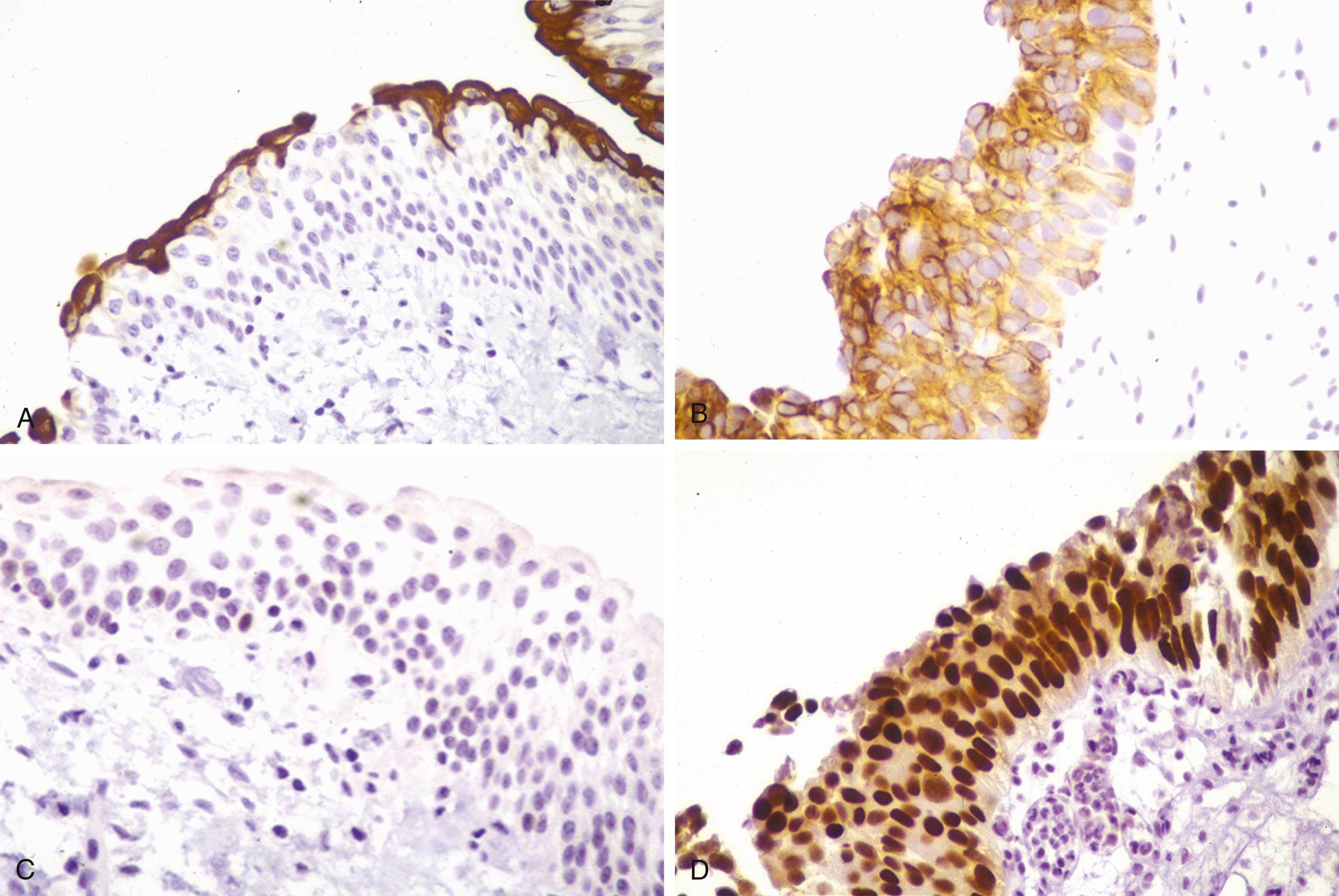
The tumor suppressor gene CDKN2A (formerly p16 ) inhibits cyclin D-dependent protein kinases and thereby plays a vital role in the regulation of G1-S transition. In fact, CDKN2A gene (9p21) deletions and mutations are frequent in bladder cancer and appear to be more frequent in low-grade superficial tumors compared with higher grade invasive tumors. , Several recent studies revealed a significant correlation between loss of p16 expression and progression in noninvasive (pTa) and superficially invasive (pT1) UC. ,
Yin and colleagues showed increased expression of p16 protein in flat urothelial CIS compared with its uniform and weak expression in normal and reactive urothelium, suggesting a potential diagnostic role for p16 immunostaining in such settings. p16 immunohistochemistry cannot be used to distinguish secondary involvement of the bladder with uterine cervical carcinoma from primary UC.
The retinoblastoma gene ( RB1 ) encodes a nuclear protein, pRb, which plays a crucial role in cell-cycle progression by regulating cell-cycle arrest at the G1-S phase. Alterations in pRb may occur either as a result of RB1 gene mutations or as a result of loss of p16, which normally phosphorylates pRb. Loss of heterozygosity (LOH) of one RB1 gene allele in combination with mutation of the remaining allele is found more frequently in MIBC. Interestingly, both over-expression and loss of pRb expression have been associated with increased risk for bladder cancer progression. It appears that alterations in pRb and p53 act in a synergistic manner to promote bladder cancer progression. , Thus pRb immunostaining could be a useful prognostic marker in UC.
The distinctive morphologic features of noninvasive papillary urothelial neoplasms—papilloma, papillary urothelial neoplasm of low malignant potential (PUNLMP), low-grade and high-grade noninvasive papillary urothelial carcinoma—make their diagnosis easily achieved on hematoxylin and eosin (H&E) sections. Therefore, the diagnostic role of IHC in UC is limited to (1) distinguishing high-grade invasive UC from tumors that secondarily involve the bladder from adjacent organs or, more rarely, from distant primary sites; (2) assigning a primary urothelial origin for a metastatic carcinoma of unknown primary; (3) potential utility in distinguishing CIS from reactive urothelial atypia; and (4) establishing the diagnosis in rare subtype (previously referred to as variant), such as plasmacytoid and sarcomatoid UC.
Urinary bladder involvement by a secondary tumor (either by direct extension or metastasis) occurs most commonly from colorectal (33%), prostatic (12%), and cervical (11%) sites. , Less common sources include breast, stomach, lung, and melanoma primaries.
Spread from a colonic or rectal primary could present a diagnostic challenge in bladder transurethral resection (TUR) samples. In fact, such secondary involvement is a more common occurrence than primary adenocarcinoma of the bladder. Differentiating a colorectal carcinoma (CRCa) spread from intestinal-type primary adenocarcinoma of the bladder cannot usually be achieved with certainty on histologic evaluation. The presence of a background of urothelial intestinal metaplasia with associated glandular dysplasia may favor a primary origin; however, the pathologist should consider the possibility of secondary colonization of bladder urothelial mucosa by a well-differentiated CRCa mimicking intestinal metaplasia/dysplasia. In general, a recommendation to clinically rule out spread from a colorectal primary by imaging techniques should be forwarded in order to avoid a potentially unjustifiable radical cystectomy procedure. Immunostains that include CDX2, β-catenin, villin, and CK7/CK20 have been suggested by some to be helpful. , However, some degree of overlap in staining patterns among primary enteric-type bladder adenocarcinomas and secondary colorectal adenocarcinomas still exist, which limits the utility of these markers ( Fig. 17.2A–F ).
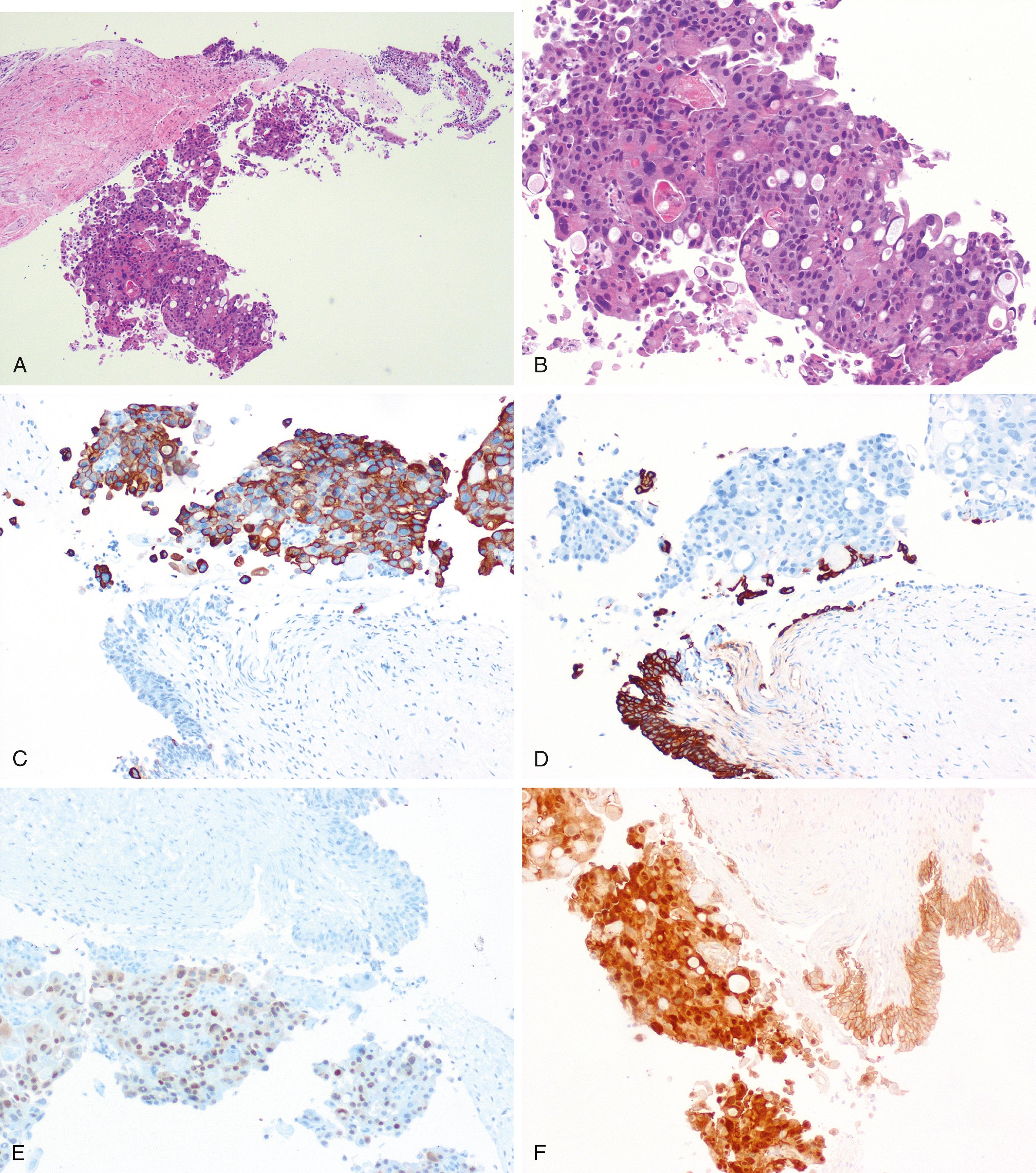
The second most common source of secondary tumor involvement of the bladder is PCa. Even in cases in which a prior known history of PCa is given, superimposed morphologic changes, such as squamous differentiation as a result of prior hormonal or radiation treatment, lead to additional difficulty in distinguishing PCa recurrence from a second primary UC, on a transurethral resection of prostate (TURP) or needle biopsy. As mentioned in the discussion of prostate tumors, poorly differentiated PCa may have enlarged nuclei and prominent nucleoli, yet little variability in nuclear shape and size is usually found in PCa. High-grade UC often reveals a more pronounced nuclear pleomorphism. UC tends to grow in nests, even when poorly differentiated, and usually lacks the cribriform and cord-like architecture of PCa. However, in the absence of a noninvasive flat or papillary UC component, it is difficult on limited material to distinguish high-grade PCa that involves the bladder from primary high-grade infiltrating UC on routine H&E-stained sections. Given the crucial difference in management and prognosis, resorting to immunostains is a must if the distinction could not be made with absolute certainty on morphologic grounds.
As mentioned in Chapter 16 on prostate, PSA and prostate-specific acid phosphatase (PSAP) have proved to be useful in identifying prostate lineage. However, the sensitivities of PSA and PSAP decrease in poorly differentiated PCa, and newer markers such as prostein (P501S), PSMA, proPSA (pPSA), and NKX3.1 may be of added utility. Combining the previously listed markers with urothelial lineage markers, such as TM and uroplakin, will further facilitate resolving a urothelial versus a prostatic differential ( Table 17.2 ).
| Carcinoma | HMWCK (%) | p63 (%) | Thrombomodulin (%) | GATA3 (%) | PSA (%) | P501S (%) | PSMA (%) | NKX3-1 (%) | pPSA (%) |
|---|---|---|---|---|---|---|---|---|---|
| Prostate | 0 | 7.9 | 0 | 5.3 | 94.7 | 97.4 | 100 | 92.1 | 94.7 |
| Urothelial | 86 | 91.4 | 82.9 | 68.6 | 0 | 0 | 5.7 | 0 | 0 |
It should also be kept in mind that both UPIII and TM are of only moderate sensitivity, compared with HMWCK and p63, in labeling UC. Recent studies have documented HMWCK positivity in more than 90% of UC. , HMWCK is only rarely and focally expressed in PCa (8%), and p63 has a greater specificity for UC, albeit lower sensitivity, compared with HMWCK (100% specificity, 83% sensitivity). Finally, our experience shows that CK7 and CK20 are of limited utility in this differential, given that they may both be positive in a subset of PCa. , GATA3 has achieved better sensitivity and specificity in labeling UC and ruling out prostate adenocarcinoma.
Among other rare sources of tumors that metastasize to the bladder, mammary carcinoma deserves a cautionary note. The possibility of a breast metastasis should be raised when epithelial infiltration is seen in the form of cords or individual plasmacytoid to signet-ring-shaped cells that involve lamina propria without associated overlying papillary urothelial proliferation or CIS. In such cases, the differential should also include a rare subtype of UC, plasmacytoid subtype ( Fig. 17.3A–C ). Obtaining a proper clinical history and the use of IHC to include estrogen and progesterone receptors, gross cystic disease fluid protein (GCDFP), mamoglobin, UPIII, and TM will help reach a proper diagnosis. Finally, positive reactivity for CD138 in the plasmacytoid subtype of UC can lead to a misdiagnosis of plasma cell dyscrasia if a proper battery of immunostains is not utilized.
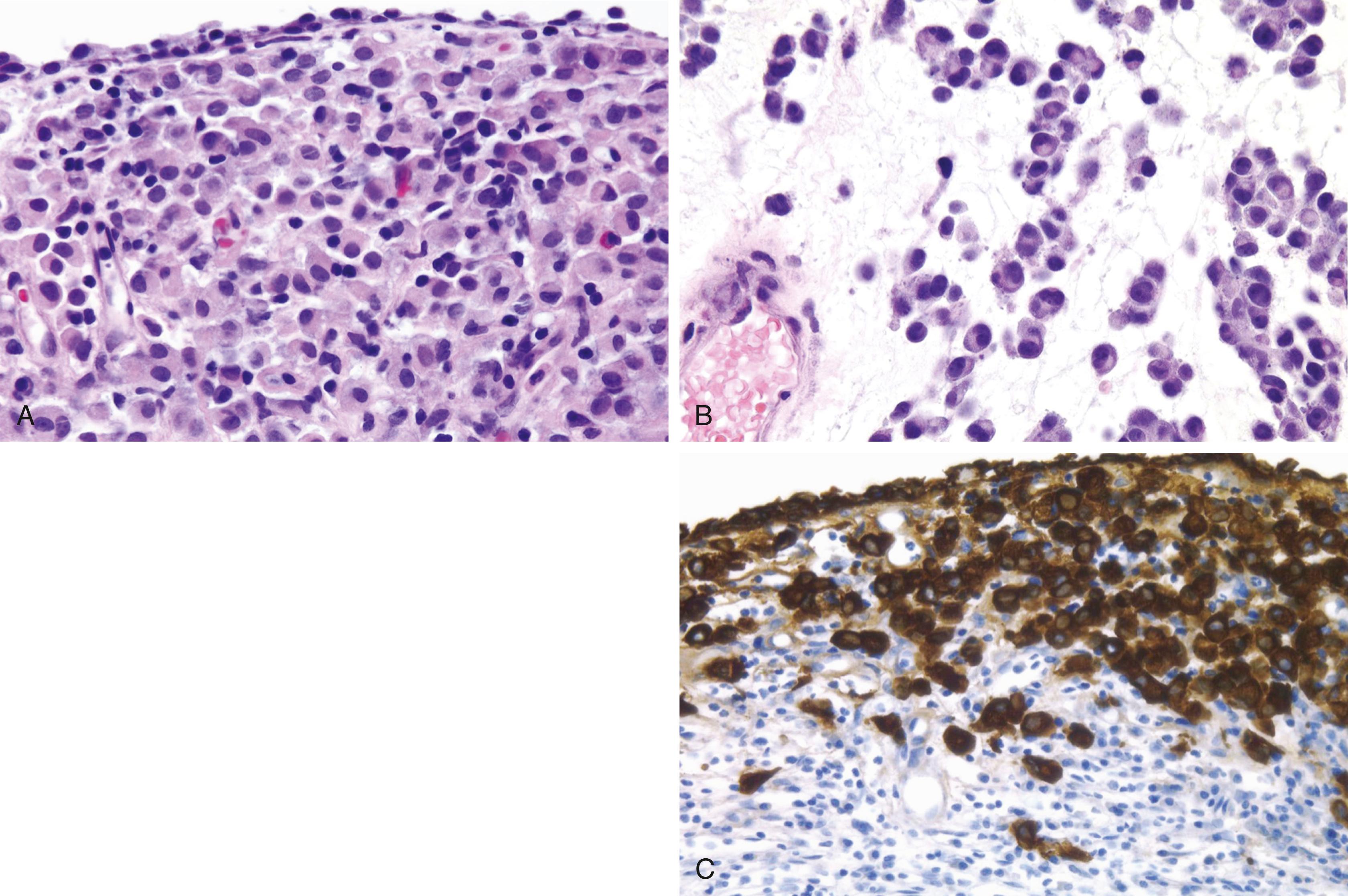
In the workup of metastatic carcinoma of unknown primary origin, inclusion of GATA3, CK7, CK20, HMWCK, TM, and UPIII is needed to rule out urothelial primary. Using a panel of four of the latter markers, excluding CK7, in a wide range of 112 urothelial tumors, Parker and colleagues revealed that expression pattern varied with tumor grade and stage ( Table 17.3 ). UC subtypes showed staining similar to that of conventional UCs. In the same study, UPIII immunoreactivity was never seen in tissue cores of nonurothelial tumors, rendering the expression of UPIII in a tumor almost diagnostic of urothelial origin. Although coexpression of TM, HMWCK, and CK20 strongly suggests urothelial origin, none of these markers is as specific as UPIII and GATA3. This is because TM is expressed in nonurothelial tumors, such as non-small cell lung carcinomas (27%) and rare lymphomas, and HMWCK is expressed by 43% of non-small cell lung carcinomas and mesotheliomas, among others.
| Grade/Stage | UPIII ( n ) (%) | TM ( n ) (%) | HMWCK ( n ) (%) | CK20 ( n ) (%) |
|---|---|---|---|---|
| LMP ( n = 14) | 12 (86) | 12 (86) | 13 (93) a | 6 (43) |
| LG ( n = 16) | 12 (75) | 16 (100) | 10 (63) | 8 (50) |
| HG ( n = 16) | 13 (81) | 12 (75) | 11 (69) b | 12 (75) |
| INV ( n = 36) | 14 (39) | 22 (61) | 30/34 (88) b | 17/34 (50) |
| MET ( n = 25) | 13 (52) | 15 (60) | 24 (96) b | 10 (40) |
Among UC subtypes, sarcomatoid carcinoma deserves special attention because of its likelihood to be confused with “true” mesenchymal neoplasms, such as leiomyosarcoma, osteosarcoma, and rhabdomyosarcoma. This is more likely when heterologous elements are displayed and noninvasive papillary or in situ urothelial components are not evident. Reactivity for one or more of the markers AE1/AE3, CAM5.2, epithelial membrane antigen (EMA), HMWCK, p63, CK7, and CK20 supports the diagnosis of sarcomatoid carcinoma, although caution should be used with positivity for CAM5.2 and p63 because they can be seen in sarcomas. Positive reactivity for actin can be encountered in sarcomatoid carcinoma and should not mislead the observer to a diagnosis of leiomyosarcoma. As discussed later, attention to differentiating sarcomatoid carcinoma from IMT is also crucial.
Primary adenocarcinomas of the bladder are relatively rare; therefore, establishing their diagnosis requires the exclusion of secondary involvement by direct extension or metastatic spread. Bladder adenocarcinomas include signet-ring cell carcinomas and mucinous, and enteric adenocarcinomas. Urachal carcinomas are also frequently glandular. Distinguishing a PCa that extends into the bladder from a primary bladder adenocarcinoma is important and has critical clinical and management implications. IHC markers of prostate lineage are of great utility in this regard. Although the specificity of newer prostate lineage markers have been tested against bladder UC, the same cannot be said about their pattern of reactivity in bladder adenocarcinoma. Assessing 37 adenocarcinomas of the bladder, we have demonstrated that a minority of bladder adenocarcinomas are positive for prostate antigens P501S and PSMA. P501S showed moderate diffuse cytoplasmic staining in 11% of cases, including enteric-type and rare mucinous adenocarcinomas. The granular perinuclear staining pattern of P501S typically seen in prostatic adenocarcinoma was absent in all cases of bladder adenocarcinoma. In addition, PSMA showed diffuse cytoplasmic or membranous staining in 21% of bladder adenocarcinomas, including signet-ring, urachal, mucinous, and enteric-type subtypes. All cases were negative for PSA and PSAP; therefore, immunoreactivity for P501S and PSMA should be interpreted with caution in such settings ( Fig. 17.4A –C). The lack of granular perinuclear staining for P501S and the absence of membranous PSMA staining both favor a bladder adenocarcinoma.
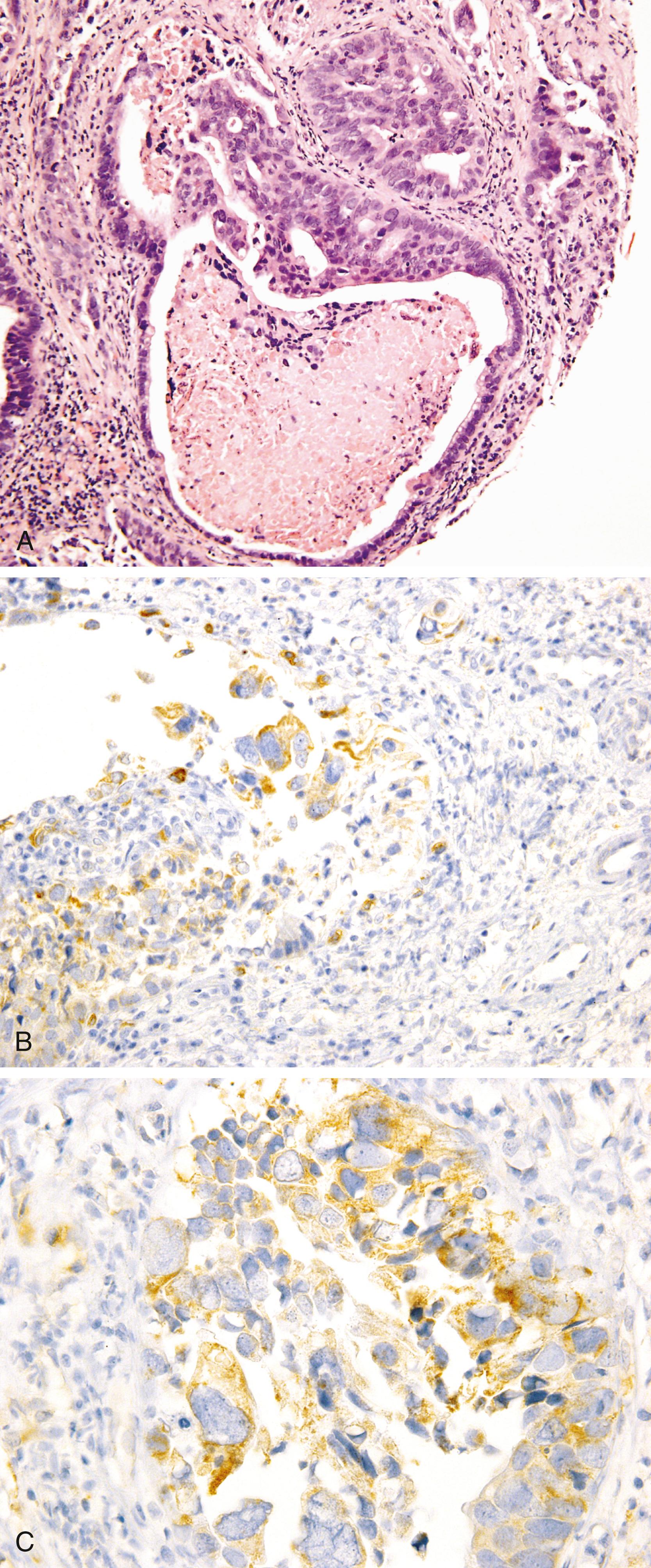
Small cell neuroendocrine carcinoma of the bladder is a rare but aggressive tumor. It occurs either in pure form or more commonly admixed with urothelial CIS, invasive UC, SCC, or an adenocarcinoma component. Clinically, small cell neuroendocrine carcinoma presents at an advanced stage with visceral and bone metastases and can be associated with paraneoplastic syndromes. In one of the largest series by Cheng and associates, a dismal 5-year survival rate of 16% was encountered despite adopting a multimodal therapeutic approach that included chemotherapy and radical cystectomy. In our experience, immunostains for neuroendocrine markers are only rarely needed (synaptophysin+, chromogranin+, and CD56+), especially when a non–small cell component is associated. The presence of typical small cell morphology similar to that encountered in the lung counterpart with characteristic brisk mitotic activity and extensive necrosis facilitate the diagnosis. In cases in which the differential diagnosis includes malignant lymphoma or other “small blue cell” tumors, pancytokeratins AE1/AE3 and CAM5.2, in addition to the previously listed neuroendocrine markers, can help establish the diagnosis.
Small cell neuroendocrine carcinoma of bladder has a high number of genomic alterations. In their analysis of a single tumor having areas of both small cell and UC, Cheng and associates revealed genetic evidence that strongly suggests that small cell carcinoma can develop from UC through the acquisition of additional genetic alterations. Deletions are most frequent at 10q, 4q, 5q, and 13q chromosomal locations. These regions may carry tumor suppressor genes with relevance for this particular tumor type. Gains at 8q, 5p, 6p, and 20q and amplifications at 1p22-32, 3q26.3, 8q24, and 12q14-21 suggest localization of oncogenes at these loci.
Recently, among the TCGA molecular expression-based subtypes of bladder cancer, a “neuronal” subtype was recognized that included tumors with neuroendocrine (NE) and additional tumors that had no histopathologic features of neuroendocrine origin. These tumors showed relatively high expression of neuronal differentiation and development genes, as well as typical neuroendocrine markers. Half of the tumors in this molecular subtype show loss of TP53 and RB1 (a hallmark of small cell neuroendocrine cancer) due to mutations in both TP53 and RB1, or TP53 mutation and E2F3 amplification. Notably, this subtype had the poorest survival.
We will limit our discussion to two of the benign mimic of bladder tumors: nephrogenic adenoma (NA) as a mimic of both UC and adenocarcinoma, and IMT as a mimic of sarcomatoid carcinoma or sarcomas.
Typically, NA displays tubulopapillary structures lined by a single layer of bland cuboidal epithelial cells with low mitotic activity. Tubular structures are frequently surrounded by a distinct ring-like basement membrane and may contain eosinophilic or mucinous secretions. The tubular lining cells frequently display hobnail nuclei. Other tubules can have a flattened lining, thus leading to a false impression of lymphatic structures. Rarely, intracytoplasmic lumina can form in single cells that mimic infiltrating signet-ring carcinoma. Rare examples in which hyalinized myxoid stroma “suffocates” the compressed tubular structures, termed fibromyxoid variant of NA , can be confused with mucinous adenocarcinoma of the bladder. When typical, NA is easily recognized in TURB samples. In difficult examples, the diagnosis of NA can be supported by their unique positivity for PAX2 or PAX8. , NA is negative for HMWCK and p63 in two-thirds of cases.
Clear cell adenocarcinoma of bladder shares some immunophenotypical and morphologic features with NA. The higher degree of cytologic atypia and brisk mitotic activity found in clear cell adenocarcinoma, further illustrated by a high Ki-67 index, can help distinguish it from NA ( Fig. 17.5A –D). ,
Variable expression of high-molecular-weight cytokeratin/p63; GATA3 negative
Positive for PAX2 and PAX8
Lacks malignant cytology of clear cell adenocarcinoma
Low Ki-67
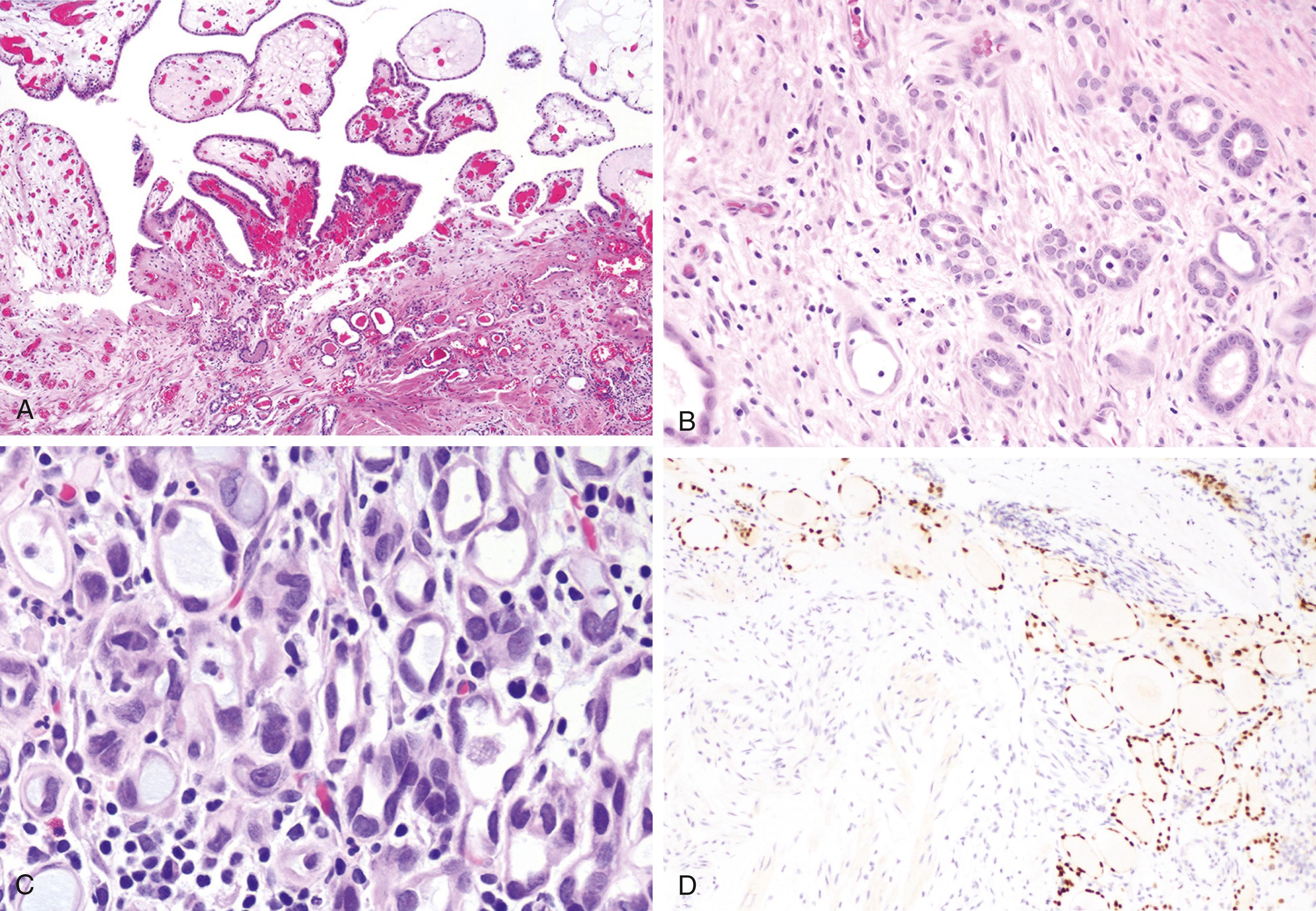
IMT of the bladder may arise spontaneously or following instrumentation of the bladder. IMTs are benign mesenchymal neoplasms composed of a proliferation of relatively monotonous myofibroblastic cells (typical tissue culture appearance) in a richly vascularized background with red blood cell extravasation and lympho-plasmacytic inflammatory infiltrate. Mitotic activity ranges from absent to brisk, but abnormal mitotic figures are not present. Although IMTs may occasionally recur (25%), only one case of malignant transformation of IMT has been reported in the genitourinary tract. As mentioned above in the section on ALK, two-thirds of IMTs contain rearrangement of the ALK gene on chromosome 2p23 with different translocation partners. The rearrangement can be demonstrated by split-apart interphase cytogenetic FISH techniques ( Fig. 17.6A and B). The translocation also leads to ALK protein over-expression on IHC ( Fig. 17.7A –C). IMTs are frequently immunoreactive for pancytokeratin and CAM5.2, a fact worth remembering when attempting to differentiate IMT from sarcomatoid carcinoma. They are frequently positive for smooth muscle actin (SMA) and desmin, which may lead to their misinterpretation as leiomyosarcoma. IMT is usually negative for CD34, S100 protein, and CD117 ( Table 17.4 ).
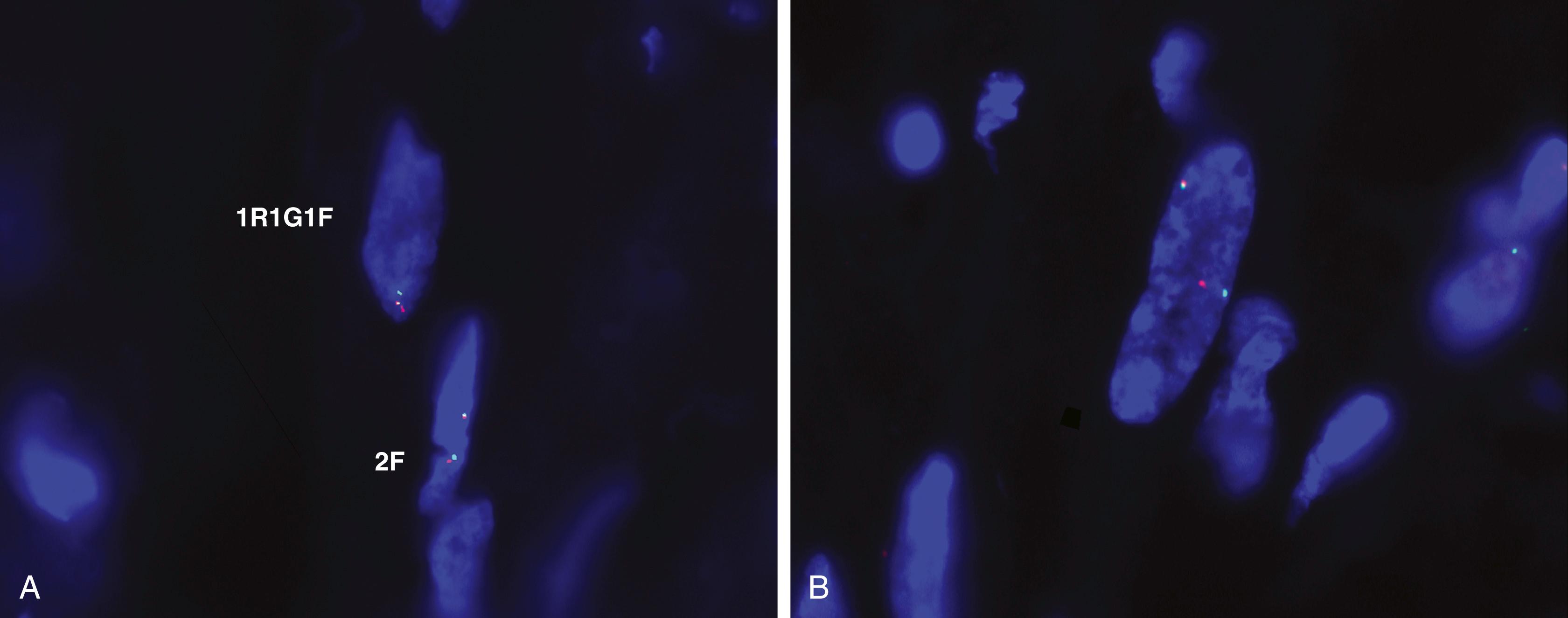
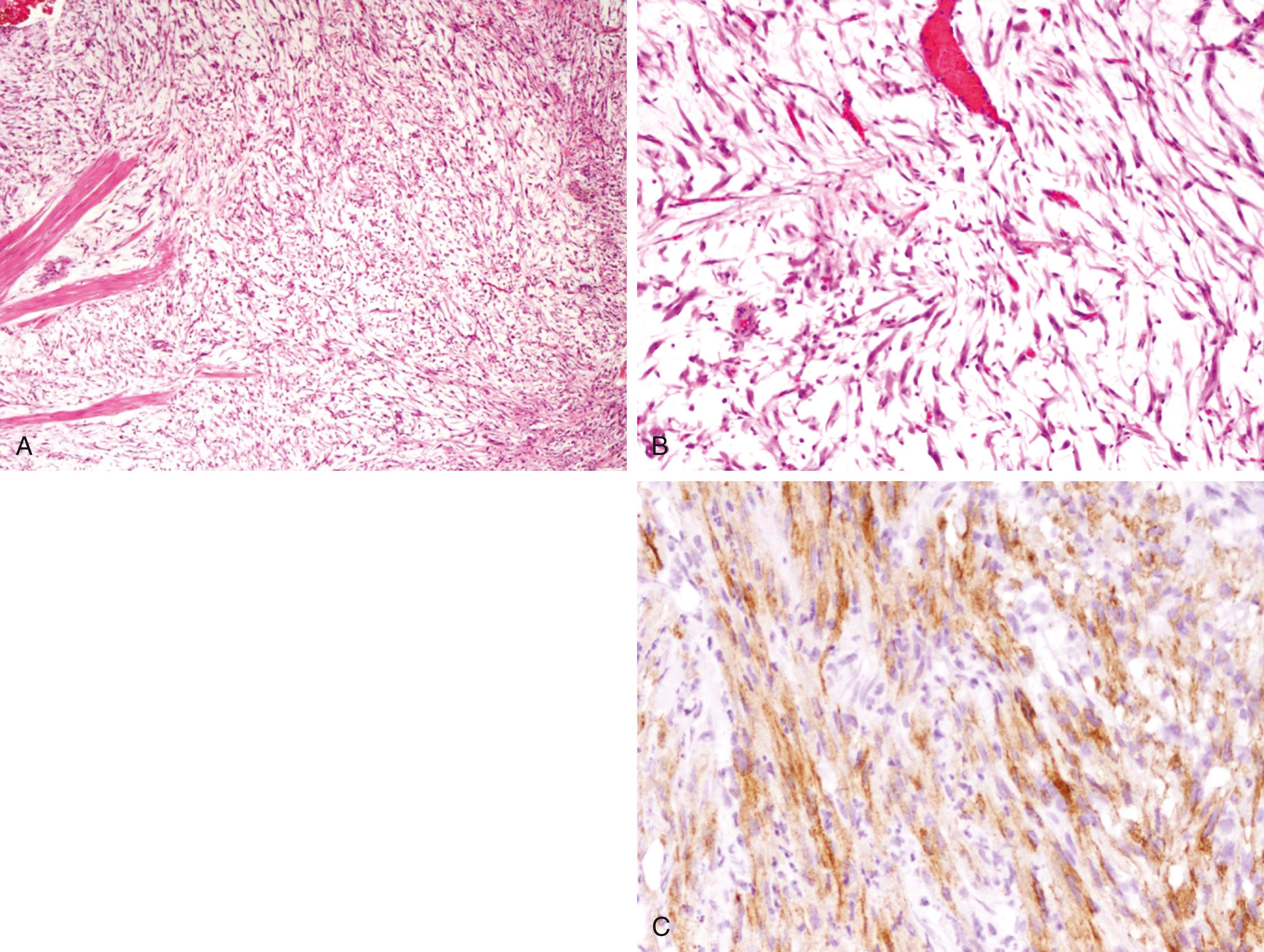
| IMT | Sarcomatoid UC | Leiomyosarcoma | Rhabdomyosarcoma | |
|---|---|---|---|---|
| Keratin | + | + | S | − |
| EMA | − | + | − | − |
| Vimentin | + | + | + | + |
| Desmin | + | − | + | + |
| MSA | + | S | + | + |
| Alk | S | − | − | − |
Accumulating molecular genetic evidence supports two distinct broad pathogenetic pathways for bladder cancer (BC) development that seem to parallel the contrasting biological and clinical phenotypes of NMIBC (superficial) and MIBC. Whereas the majority of invasive UCs are thought to originate through progression from dysplasia to flat CIS and high-grade noninvasive lesions, superficial urothelial lesions are thought to originate from benign urothelium through a process of urothelial hyperplasia. Progression from NMIBC to muscle-invasive disease accounts for only a small percentage (10% to 15%) of the entire pool of noninvasive tumors. Genetic instability is key in the accumulation of genetic alterations required for progression to MIBC.
Clinically, a significant proportion of papillary NMIBC (pTa and pT1) are destined to recur following TURB, and only a minority of cases endure progression to high-grade carcinoma that will ultimately progress to MIBC.
Three primary genetic alterations have consistently been associated with the pathogenesis pathway of NMIBC. These involve tyrosine kinase receptor FGFR3 , H-RAS , and PIK3CA. , , Alterations in the RAS-MAPK and PIK3CA-Akt pathways are in large part responsible for promoting cell growth in urothelial neoplasia. Activating mutations in the RAS family of genes leads to activation of mitogen-activated kinase-like protein ( MAPK ) and PIK3CA pathways. Not surprisingly, activating mutations in the upstream tyrosine kinase receptor FGFR3 seems to be mutually exclusive with RAS mutations, given that both signal through a common downstream pathway in urothelial oncogenesis. PIK3CA and FGFR3 mutations generally co-occur, suggesting a potential synergistic, additive, oncogenic effect for PIK3CA mutations.
The pathogenic pathway for MIBC primarily involves alterations in tumor suppressor genes involved in cell-cycle control, including TP53 , CDKN2A , and RB1 ( Figs. 17.8 and 17.9 ). 62,85,88 As illustrated in Fig. 17.8 , progression of a subset of NMIBC into higher grade muscle-invasive disease is similarly based on alterations in TP53 and RB1 tumor suppressor genes. ,
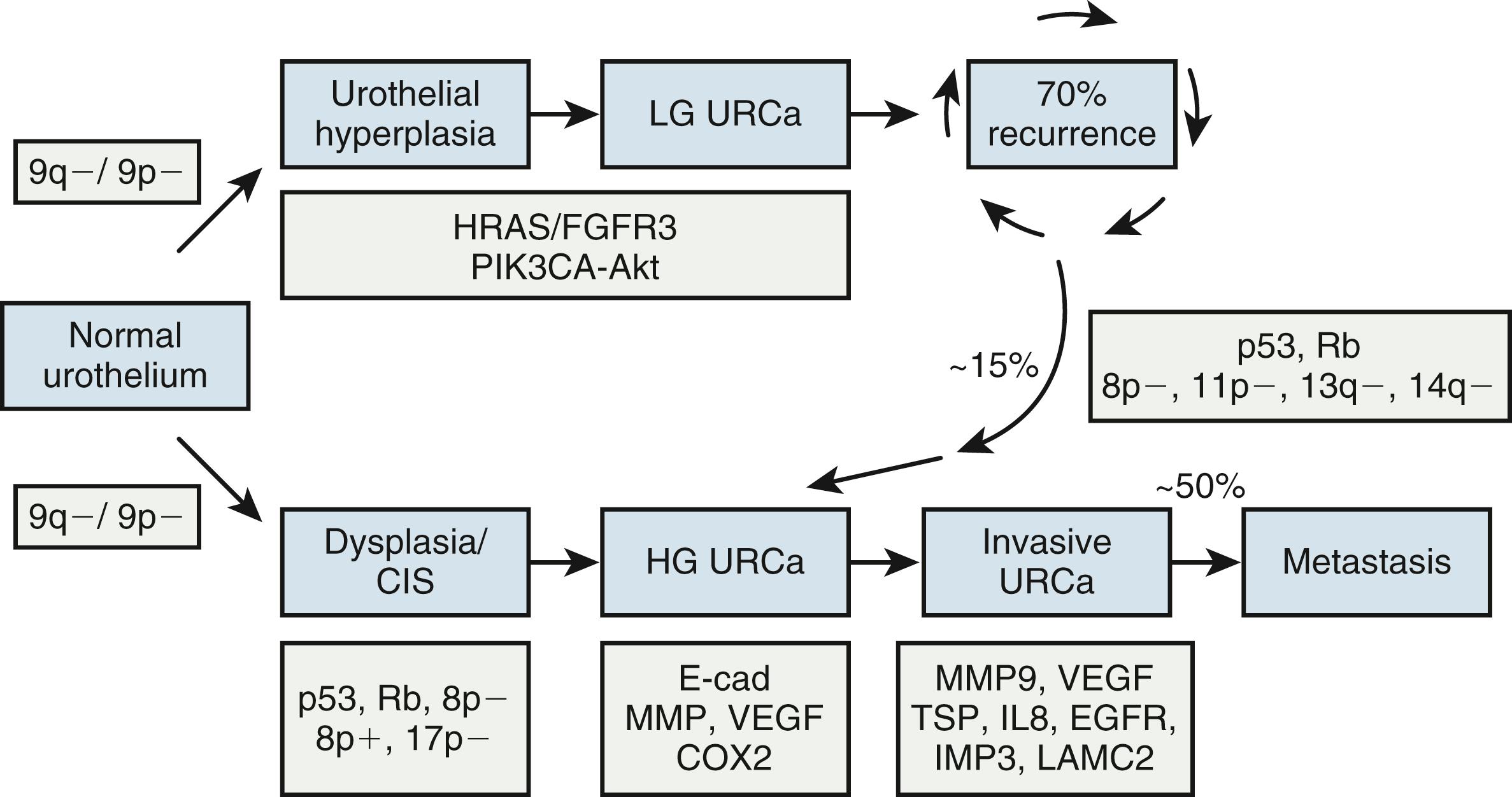
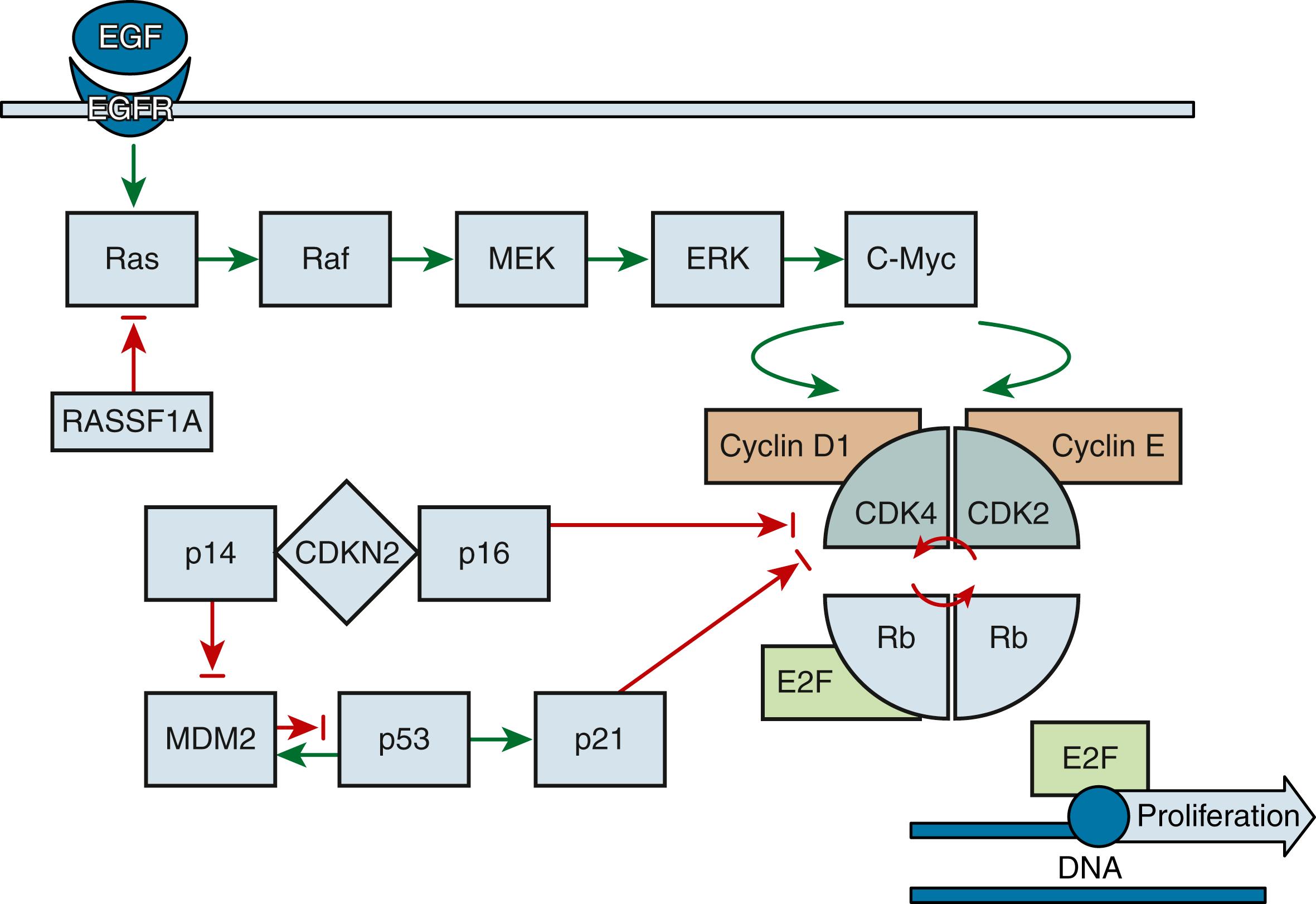
Established clinicopathologic prognostic parameters for NMIBC include pT stage, World Health Organization (WHO)/International Society of Urological Pathology (ISUP) grade, tumor size, multifocality, presence of CIS, and frequency and rate of prior recurrences. Prognostic parameters that can predict progression in NMIBC are actively sought to identify patients in need of more vigilant surveillance and aggressive treatment. The latter is especially pertinent in a disease in which the financial burden and loss of quality of life for patients under surveillance are significant. Per patient, bladder cancer is the most expensive single solid tumor in the United States, with a staggering $3 billion estimated annual cost to our health care system. Furthermore, given the current poor outcome of muscle-invasive disease (60% or less overall survival rate), markers that can improve prognostication in this group of patients are also needed. , ,
As our understanding of the molecular pathways involved in urothelial oncogenesis increasingly comes into focus, the translational field of molecular prognostication, theranostics, and targeted therapy in BC has sharply gained momentum. , , , Initial retrospective discovery studies need to be confirmed and validated in large independent cohorts. The subsequent crucial step is validating the robustness of the proposed biomarker in a well-controlled multi-institutional randomized prospective study. Such prospective study should support an additive role for the inclusion of the new biomarker over existing management algorithms. , The lack of the latter crucial steps in biomarker development has hindered the streamlining of clinical utilization of several promising markers in BC patient management.
Prior to the propagation of next generation sequencing (NGS) based studies, the painstaking search for diagnostic, prognostic, and predictive markers in BC yielded a plethora of biomarkers that were thought to be of great potential. Regrettably, with rare exceptions, these “pre-genomic era” biomarkers never transitioned into routine use. This makes the adoption of recent genomic-based classifications of molecular subtypes of BC (see “Intrinsic Molecular Genomic Subtypes of Bladder Cancer”) an even more pressing objective.
Chromosome 9 alterations are the earliest genetic alterations in both pathways of BC development described previously. They are responsible for providing the necessary milieu of genetic instability that, in turn, allows for the accumulation of subsequent genetic defects. Several additional structural/numeric somatic chromosomal alterations are a common occurrence in BC. Among these, gains of chromosomes 3q, 7p, and 17q and 9p21 deletions ( CDKN2A locus) are of special interest, given their potential diagnostic and prognostic value. , A multitarget interphase FISH-based urine cytogenetic assay developed based on these numeric chromosomal alterations is commercially available ( Fig. 17.10 ). Initially approved by the Food and Drug Administration (FDA) (UroVysion) for surveillance of recurrence in previously diagnosed BC patients, the test subsequently gained approval for screening in high-risk (smoking exposure) patients with hematuria. The multicolor FISH assay appears to enhance the sensitivity of routine urine cytology analysis and can be used in combination with routine cytology as a reflex testing in cases with atypical cytology. A sensitivity range of 69% to 87% and a specificity range of 89% to 96% have been reported with the multitarget interphase FISH assay. With a rare exception , multitarget FISH urine assay has been shown to be more sensitive than routine cytology. An additional advantage of urine-based FISH testing is the anticipatory positive category of patients identified by such assay. This refers to patients in whom FISH assay detects molecular alterations of BC several months prior to detection by cystoscopy or routine cytology. In the study by Yoder and colleagues, two-thirds of the 27% of patients categorized as “anticipatory positive” developed BC that was detected by cystoscopy up to 29 months later . Such results initially pointed to lead time in early detection. However, the fact that many of these patients failed to develop clinically detectable disease on extended surveillance highlights the high burden of “false positive” of multitarget FISH urine assay and the need for assays with better specifity.
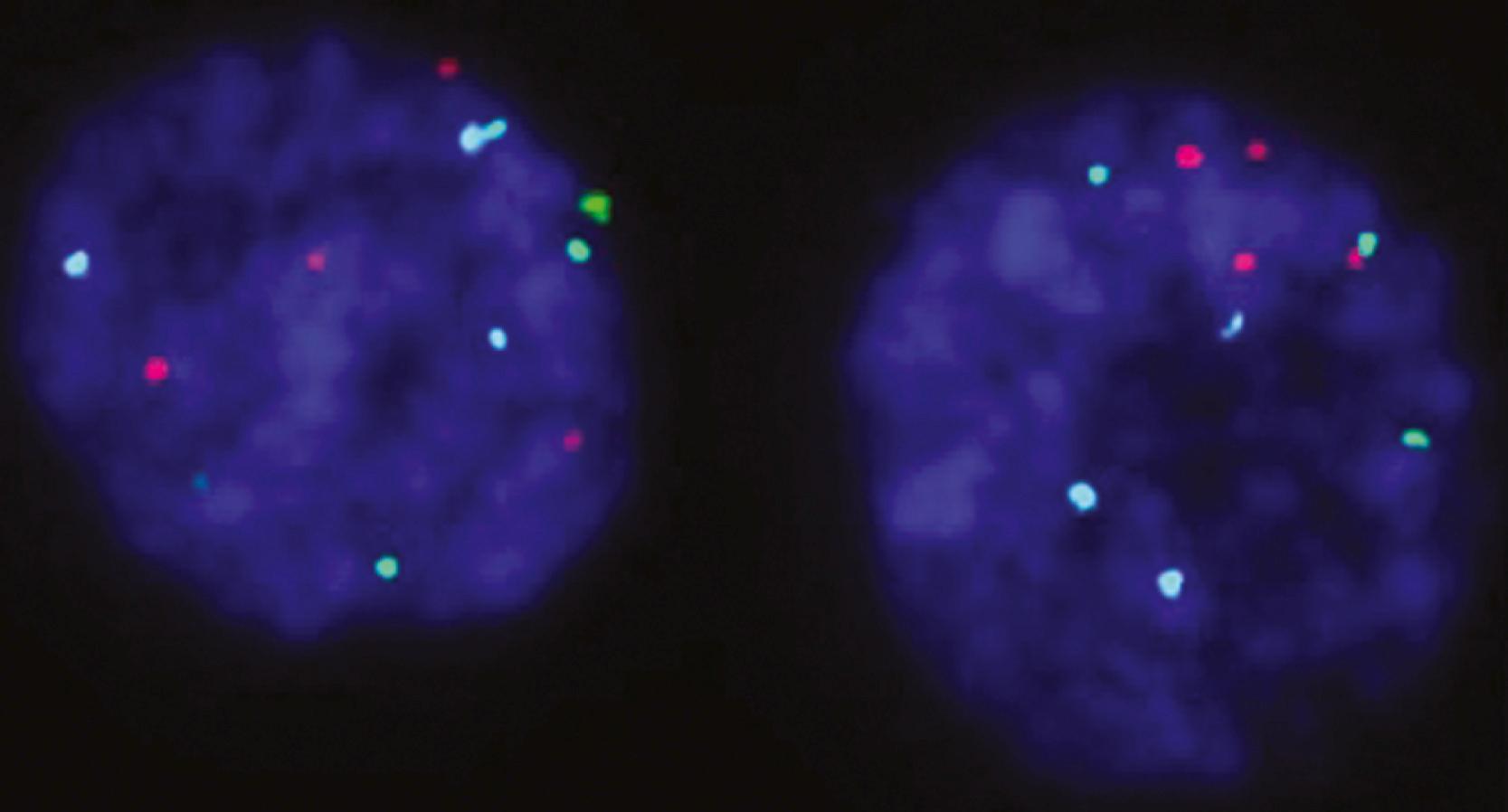
In addition to multitarget FISH, several FDA-approved noninvasive urine assays (e.g., ImmunoCyt/uCyt+™, NMP22®, and BTA®) are available for both early detection and surveillance of BC. Sensitivity and specificity for these assays range from 56% to 78% and 74% to 88%, respectively.
More novel early detection assays have harnessed the power of NGS technology applied to urine cell free DNA (cfDNA) or cellular DNA. These assays detect variable sets of genetic alterations of bladder cancer. , One such assay was recently developed by our group. When combined with cytology, it achieved a sensitivity of 95% and a specificity of 93% for early detection of BC. The assay, termed “UroSEEK,” detects TERT promoter mutations (an alteration that we found to occur in up to 80% of bladder cancers) together with 10 additional genes than include FGFR3, PIK3CA, HRAS, KRAS, TP53, CDKN2A, and ERBB2 . , ,
Numerous studies have pointed to the prognostic value of receptor tyrosine kinases (RTKs), such as FGFR3 , EGFR , and other ERB family members ( ERBB2 [formerly HER2/neu ] and ERBB3 ), , in BC.
FGFR3 mutations are a common occurrence in NMIBC and can theoretically be used alone or combined with RAS and PIK3CA oncogenes as markers of early recurrence. Zuiverloon and colleagues and Miyake and associates independently developed sensitive polymerase chain reaction (PCR) assays for detecting FGFR3 mutations in voided urine. A positive urine sample by the assay developed by Zuiverloon’s group was associated with concomitant or future recurrence in 81% of NMIBC. An even higher positive predictive value of 90% was achieved in patients with consecutive FGFR3- positive urine samples.
Kompier and colleagues were able to develop a multiplex PCR assay for mutational analysis that detects the most frequent mutation hot spots of HRAS , KRAS , NRAS , FGFR3 , and PIK3CA in FFPE TURB samples. They found evidence of at least one mutation in up to 88% of low-grade NMIBC.
Van Rhijn and associates proposed a molecular grade parameter (combination of FGFR3 gene mutation status and MIB-1 index) as an alternative to pathologic grade in NMIBC. Subsequently, the same group validated their proposed molecular grade and compared it with the European Organization for Research and Treatment of Cancer (EORTC) NMIBC risk score. The molecular grade was more reproducible than the pathologic grade (89% vs. 41% to 74%). FGFR3 mutations significantly correlated with favorable disease, whereas increased MIB-1 was frequently associated with pT1, high grade, and high EORTC risk scores. The addition of molecular grade to the multivariable model for progression increased the predictive accuracy of the EORTC score to 81.7%. Unfortunately, neither the EORTC score nor the molecular grade gained wide acceptance in routine practice.
Several studies have suggested a negative prognostic role for ERBB2 amplification and/or over-expression in MIBC. , Bolenz and colleagues found ERBB2-positive MIBC patients to be at twice the risk for recurrence and cancer-specific mortality.
As indicated below, ERBB2 is also emerging as possible target of therapy in BC, especially in micropapillary subtype where these alterations appear to be more prevalent. In advanced urothelial carcinoma, evaluation of FGFR3 alterations can determine eligibility for treatments with anti-FGFR agents. ,
Early studies by Sarkis and associates , , , revealed TP53 alterations to be a strong independent predictor of disease progression in BC. TP53 has also been shown to be predictive of increased sensitivity to chemotherapeutic agents that lead to DNA damage. , , Subsequent studies have further supported the prognostic role of TP53 in pT1-pT2 patients.
Among other G1-S phase cell-cycle regulators, cyclins D1 and cyclin D3, p16, p21, and p27 have been evaluated as prognosticators in NMIBC. , , , , Lopez-Beltran and associates confirmed their initial finding of the independent prognostic role of cyclin D1 and cyclin D3 over-expression in predicting progression in pTa and pT1 tumors. Their findings, however, were in disagreement with those of Shariat and colleagues, emphasizing the need for further validation in multi-institutional large cohorts of patients.
A synergistic prognostic role for combining TP53 evaluation with other cell-cycle control elements such as pRb, cyclin E1, p21, and p27 was shown in both NMIBC and MIBC. , , In a study by Shariat and colleagues, NMIBC patients with concomitant IHC alterations in all four tested markers—p53, p21, pRb, and p27—were at significantly lower likelihood of sustaining DFS. The negative predictive effect was decreased with decreasing number of altered markers (3 vs. 2 vs. 1; Fig. 17.11 ). Chatterjee and associates demonstrated a similar synergistic prognostic role for immunoexpression of multiple molecular markers (p53, pRb, and p21) in patients undergoing cystectomy for MIBC.
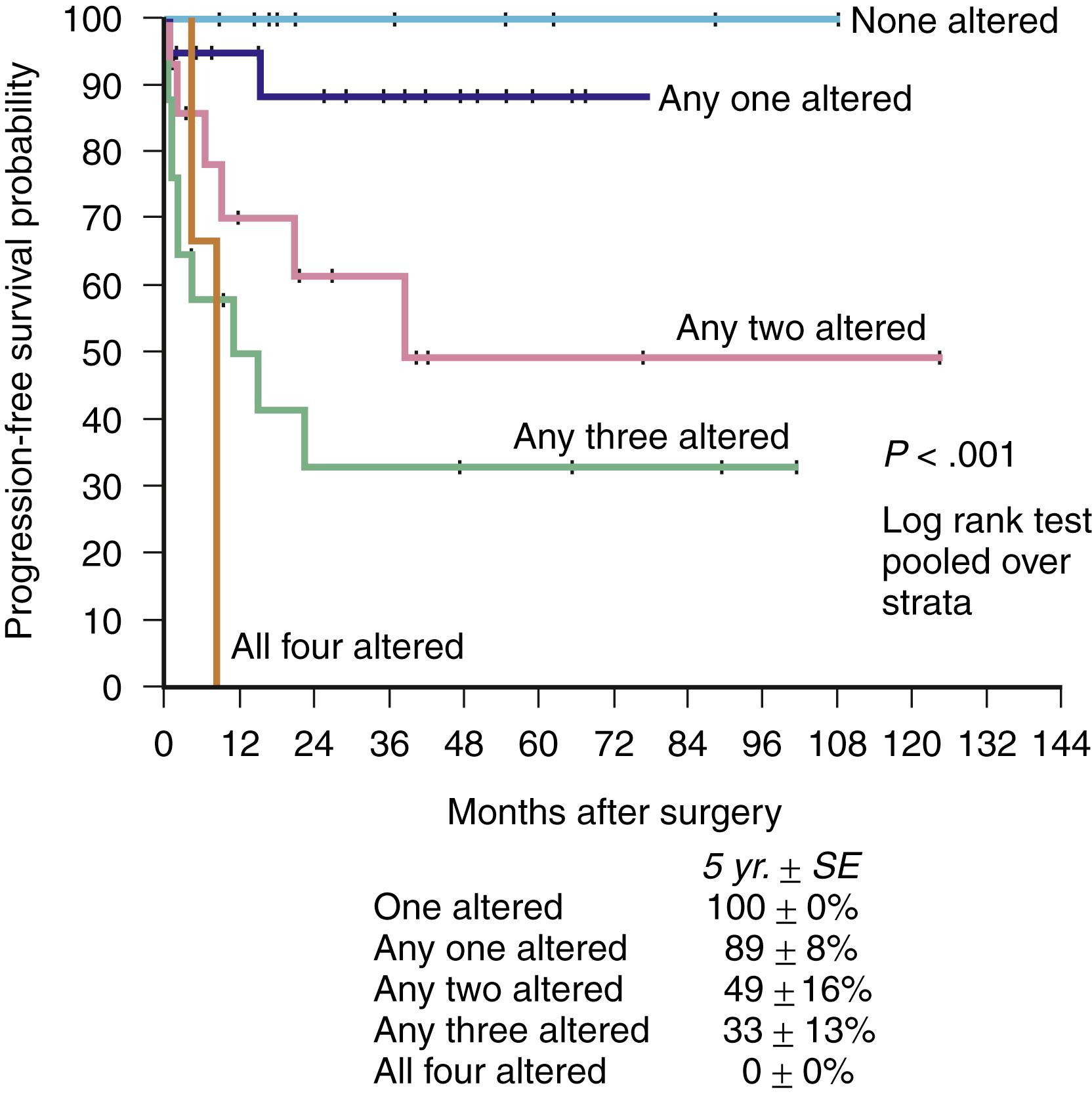
Tumor proliferation index measured immunohistochemically by either Ki-67 or MIB-1 has been consistently shown to be a prognosticator in BC. , , , , In the study by Quintero and colleagues, Ki-67 index was predictive of progression-free survival (PFS) and DSS in NMIBC.
A similar prognostic role for proliferation index has been established in MIBC, as shown in a report of the bladder consortium multi-institutional trial (7 institutions, 713 patients). Ki-67 improved prediction of PFS and DSS when added to standard prediction models, supporting a potential role in stratifying patients for perioperative systemic chemotherapy. Again, as is the case with many of the above markers, Ki-67 assessment has not made it to routine practice.
Assessment of epigenetic alterations in urine offer a noninvasive diagnostic alternative for screening and surveillance. Epigenetic analysis is also of prognostic value in BC.
In an early study by Catto and colleagues, hypermethylation analysis at 11C-phosphate-G (CpG) promoter islands was performed by methylation-specific PCR (MSP-PCR) in 116 bladder and 164 upper urinary tract tumors. Promoter methylation was found in 86% of all tumors, and the incidence was relatively higher in upper-tract tumors. Methylation was associated with advanced stage and higher tumor progression and mortality rates. On multivariate analysis, methylation at the RASSF1 and DAPK1 gene promoters was associated with disease progression independent of tumor stage and grade.
The same group, using quantitative MSP-PCR at 17 candidate gene promoters, found five loci to be associated with progression: RASSF1 , E-cadherin, tumor necrosis factor (TNF) SR25 , EDNRB , and APC . Multivariate analysis revealed that the overall degree of methylation was more significantly associated with subsequent progression and death than tumor stage. An epigenetic predictive model developed by using artificial intelligence techniques identified the likelihood and timing of progression, with 97% specificity and 75% sensitivity.
Among studies to evaluate the diagnostic role of promoter hypermethylation in urine, the study by Lin and colleagues used MSP assay in four genes— CDH1 , CDKN2A , p14 , and RASSF1 —in primary tumor and urine sediment DNA from 57 BC patients. MSP detected hypermethylation in the urine of 80% of tested patients. Hypermethylation analysis of CDH1 , p14 , or RASSF1 in urine sediment DNA detected 85% of superficial and low-grade NMIBC, 79% of high-grade BC, and 75% of invasive BC. A similar diagnostic role was also found by Cabello and associates using methylation-specific multiplex ligation-dependent probe amplification assay (MS-MLAP), to analyze 25 tumor suppressor genes (TSGs) (e.g., PTEN , CD44 , WT1 , GSTP1 , BRCA2 , RB1 , TP53 , BRCA1 , TP73 , RARB , VHL , ESR1 , PAX5 , CDKN2A , and PAX6 ). BRCA1 , WT1 , and RARB were the most frequently methylated TSGs with strong accuracy.
Genomic studies have validated the previously deciphered genetic pathways of BC development and unmasked additional crucial driver genetic alterations. Whereas earlier array-based gene expression studies highlighted differentially expressed genetic signatures that can predict recurrence and progression, , recent integrated multiplatform genomic, transcriptomic, proteomic, and epigenomic studies have defined clinically relevant molecular subtypes of BC.
Early on, Lindgren and colleagues , elucidated two main genomic molecular circuitry in BC: the first characterized by FGFR3 alterations, over-expression of CCND1, and deletions in 9q and CDKN2A, and the second characterized by E3F3 amplifications, RB1 and PTEN deletions, gains of 5p, and overexpression of CDKN2A. Advanced tumors in both groups demonstrated TP53/MDM2 gene alterations. The Lindgern et al. study was one of the first to point to the significantly worse prognosis associated with the gene expression signature of a keratinized/squamous phenotype (CK6+). The aggressive behavior of this molecularly defined subtype was also shown by Choi and colleagues. Termed “basal-like,” the subtype is characterized by p63 activation, squamous differentiation, positive CK5/6, EGFR and CD44 expression, and lack of CK20 ( Fig. 17.12 ) and is sensitive to neoadjuvant chemotherapy (NAC). Choi’s study also characterized a “luminal” subtype that is typically enriched for activating FGFR3 mutations, active estrogen receptor pathway, and ERBB2 and PPARγ expression profile (all potential targets of therapy), and a third subtype, characterized by wild-type TP53 gene expression signature (p53-Like). The latter was resistant to NAC. Interestingly, tumors from the luminal and “basal-like” subtypes also displayed the TP53 wild-type expression signature upon resistance to chemotherapy.
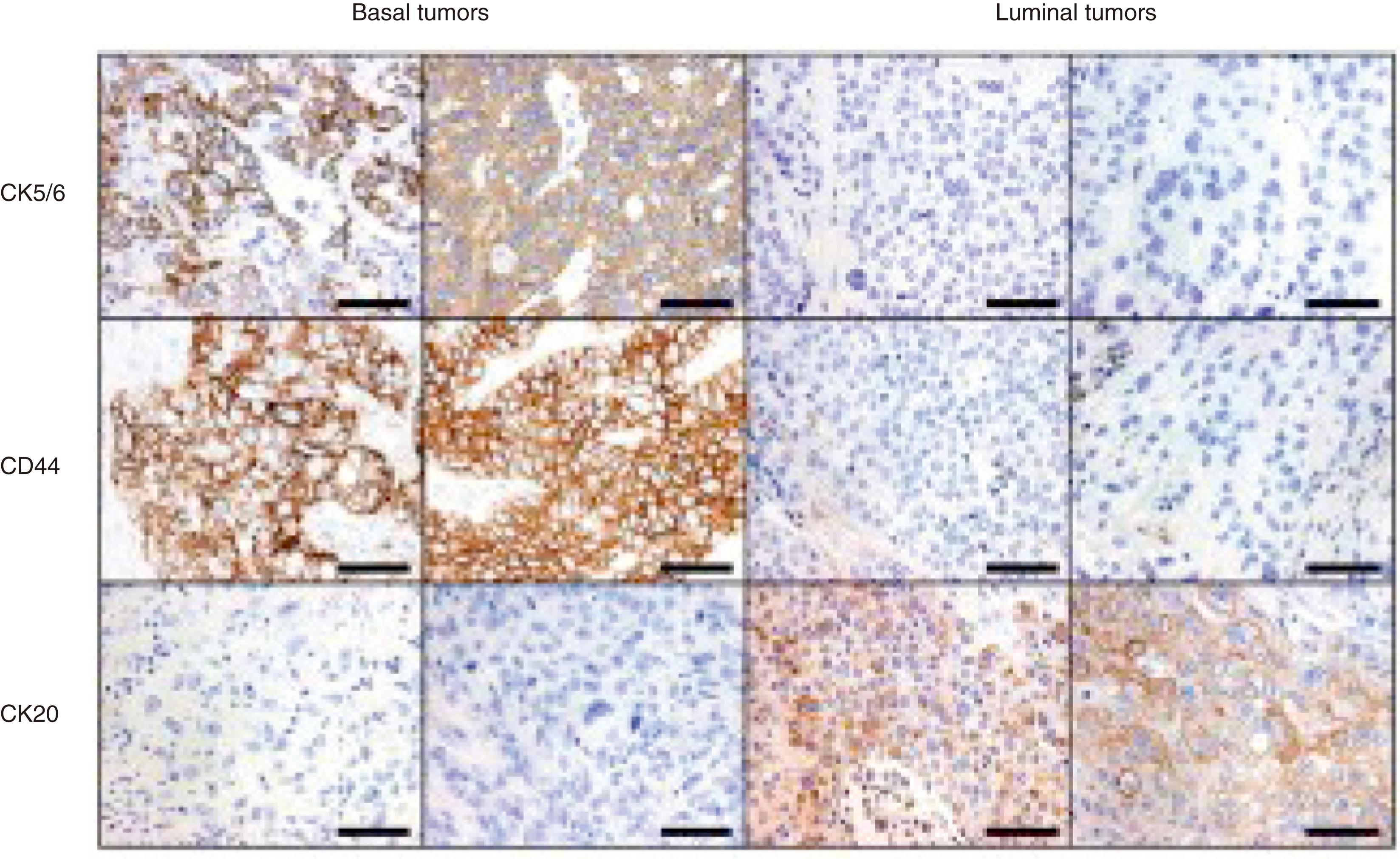
The bladder Cancer Genome Atlas project (TCGA) has culminated in two landmark reports. , In the first TCGA, the integrated analysis of 131 MIBCs revealed a staggering 302 mutations, 204 segmental copy number alterations (CNA), and 22 rearrangements on average per tumor. Recurrent driver mutations in 32 genes were found. They include genes involved in cell-cycle regulation, chromatin regulation, kinase signaling pathways, and nine additional genes (e.g., MLL2 , ERCC2 , ELF3 , KLF5 , RXRA , and CDKN1A ) not previously shown to have recurrent mutational pattern in other tumors. Integration of mRNA and miRNA sequencing data and protein expression analysis revealed four major expression clusters. Among them are “papillary-like” cluster (cluster I), enriched for FGFR3 gene alterations, papillary morphology and together with cluster II share expression of luminal urothelial differentiations markers (activated expression of ER, GATA3, uroplakin, and ERBB2). Cluster III “basal/squamous-like” was characterized by CK5/6 and EGFR expression ( Fig. 17.13 ). , ,
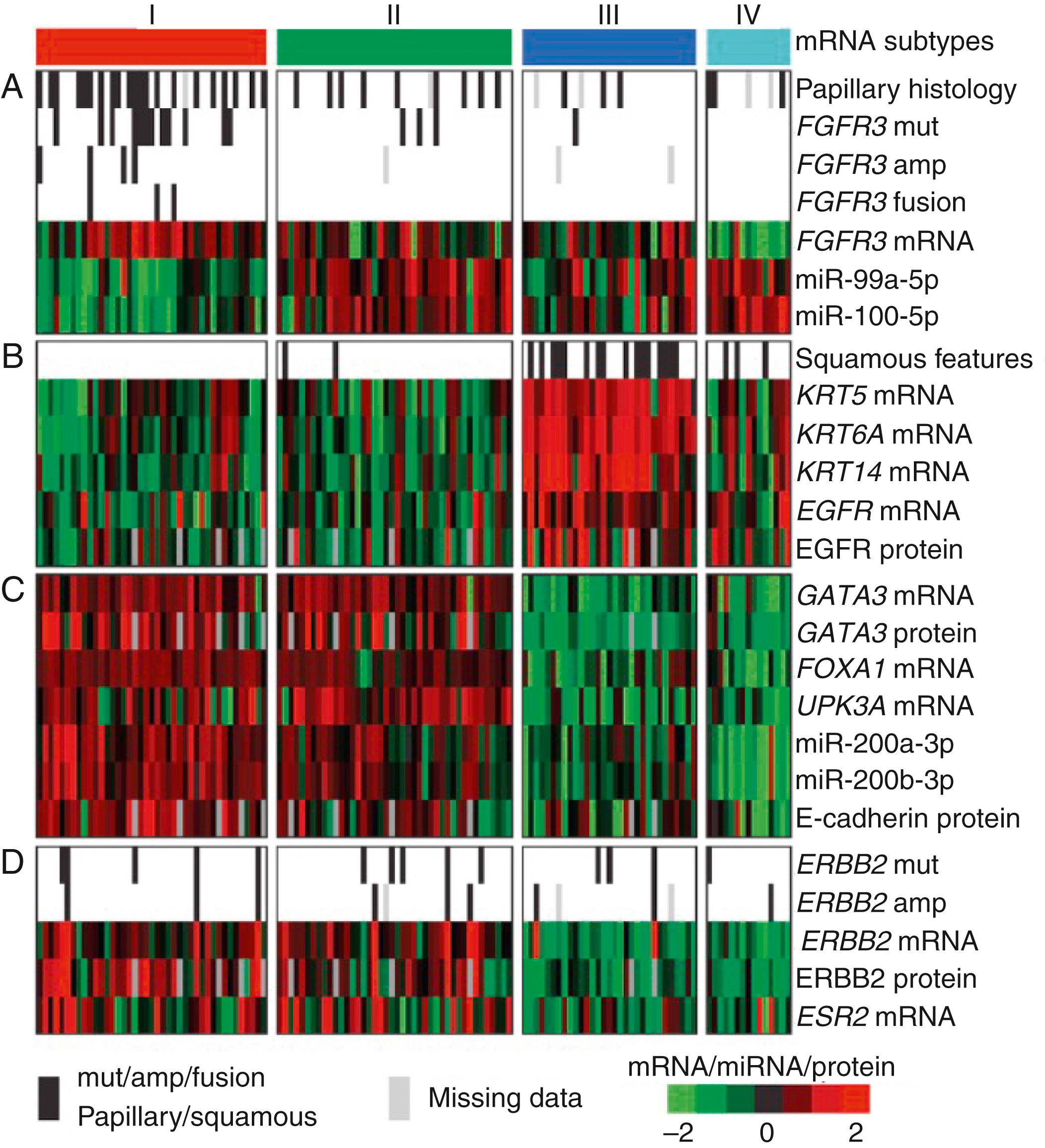
The second TCGA encompassed 412 MIBC. It expanded the list of recurrent mutations to 58 genes and revealed that the overall mutational load in BC is primarily ascribed to APOBEC induced mutagenesis signature. Clustering by mutational signatures identified a high-mutation subset of BC with 75% 5-year survival. The mRNA expression clustering of the second TCGA refined and expanded the initial TCGA clusters classification ( Fig. 17.14 ). It identified three subgroups within the luminal subtype along with a basal-squamous subtype as well a distinct neuronal cluster for a total of five TCGA subtypes. The luminal-papillary subtype (35%) was characterized by the presence of FGFR3 mutations, fusions with TACC3, and/or amplification; and papillary histology. Tumors in this subtype have lower risk for progression and are good candidates for FGFR3 inhibitors in light of their low response to cisplatin-based NAC. The luminal-infiltrated subtype (19%) is characterized by the lowest purity and high expression of EMT and myofibroblast markers. It demonstrates medium level of CD274 (PD-L1) and CTLA4 immune markers expression that may account for their response to immune checkpoint therapy. The luminal subtype (6%) shows high expression of luminal markers (e.g., Uroplakin, GATA3 and FOXA1) and KRT20. The basal-squamous subtype (35%) is characterized by higher incidence in women, presence of squamous differentiation (also include tumors without definitive squamous differentiation), high expression of basal and stem-like markers (CD44, KRT5, KRT6A, KRT14), high expression of CD274 (PD-L1) and CTLA4, and immune infiltration. Importantly, this subtype has higher likelihood of response to cisplatin-based NAC and immune checkpoint therapy. , Finally, the neuronal subtype (5%) was associated with the worst clinical outcome. Although the majority of tumors in this cluster had p53/cell-cycle pathway alterations, only a subset was associated with mutations in both TP53 and RB1 , which is the hallmark alteration in small cell/neuroendocrine. Assigning a tumor to this subtype is based on expression of neuroendocrine markers by mRNA-seq or immunohistochemistry, given the lack of typical small cell neuroendocrine morphology in the majority of tumors. Like neuroendocrine type tumors of other sites, Etoposide-cisplatin based therapy may be effective ( Fig. 17.15 ).
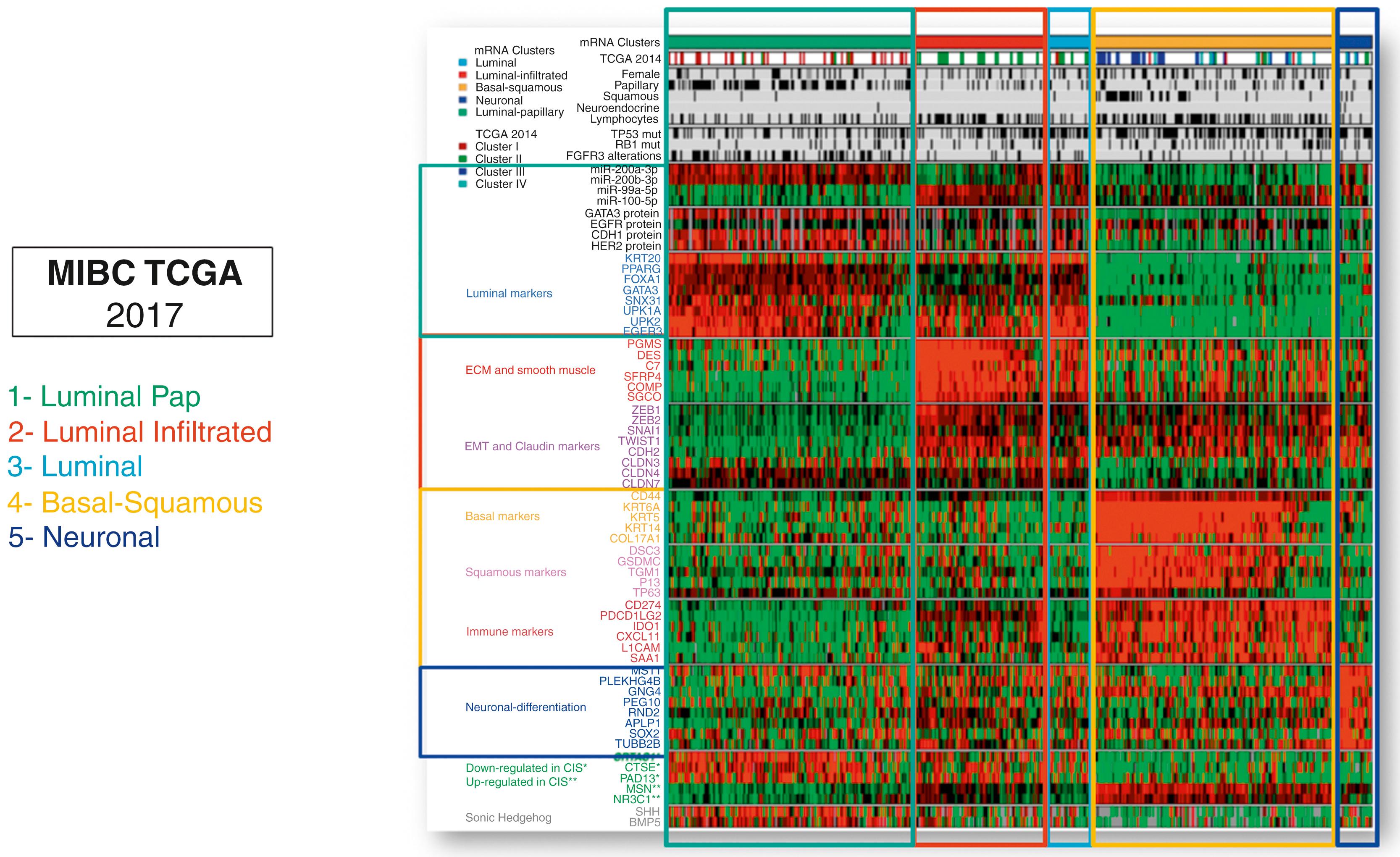
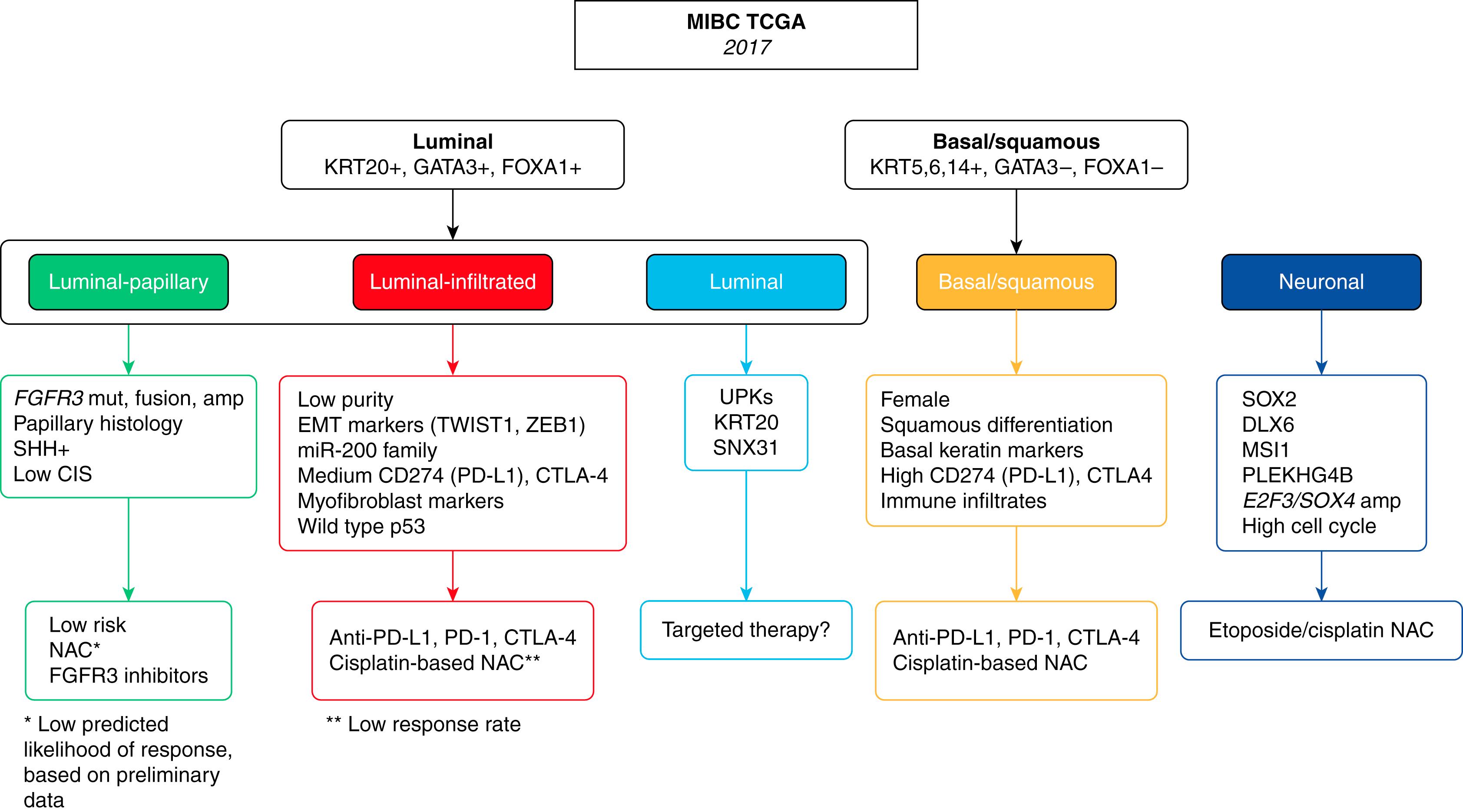
To date, a total of six MIBC molecular classifications have been proposed. Derived from largely non-overlapping datasets, the six classifications share some subtype-specific molecular features, and some overlap of their subtypes. To achieve a direly needed consensus, in 2020, a team of international multidisciplinary experts reconciled the published classification schemes in a “Consensus Molecular Classification of Muscle Invasive Bladder Cancer” proposal. The consensus included six molecular classes: luminal papillary (24% of MIBC), luminal nonspecified (8%), luminal unstable (15%), stroma-rich (15%), basal/squamous (35%), and neuroendocrine-like (3%). These classes differ in underlying oncogenic mechanisms, in their infiltration by associated tumor immune microenvironment (immune and stromal cells), and histologic and clinical characteristics, features, and outcomes ( Fig. 17.16 ).
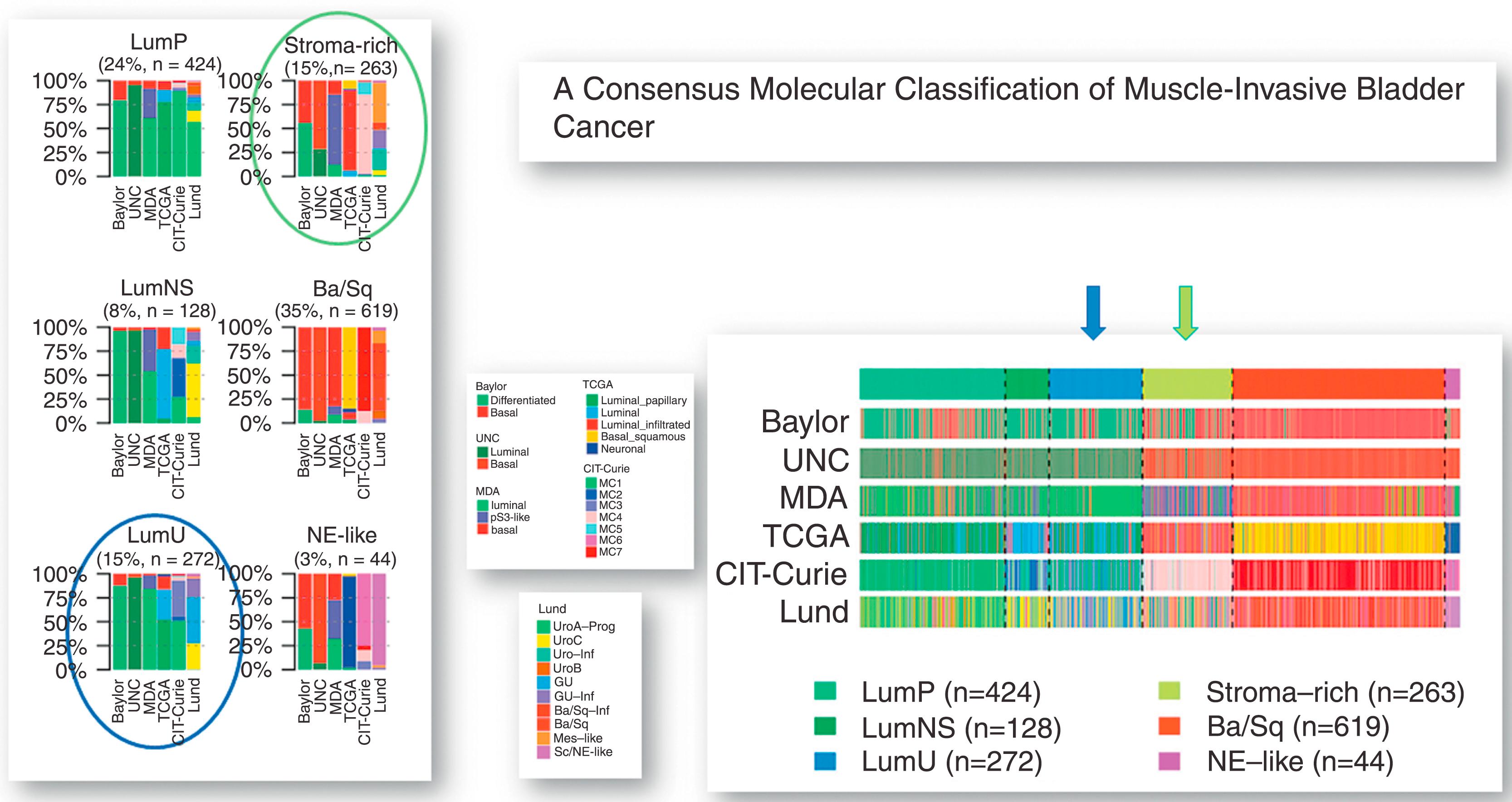
The above TCGA and genomic profiling studies uncovered a wide range of molecular therapeutic targets in the majority (>70%) of MIBC ( Fig. 17.17 ). , , The role of the novel molecular classification in predicting therapeutic response is under active investigation. ,
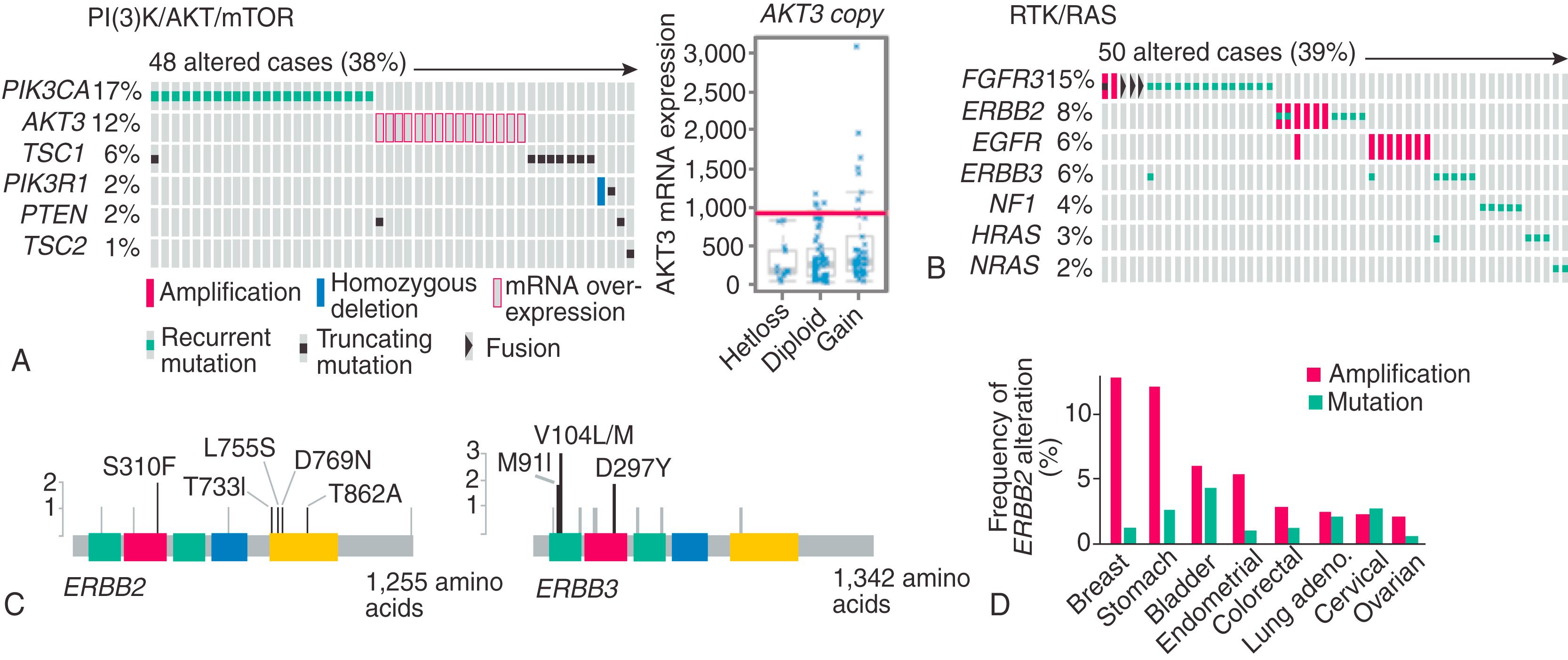
Molecular targets include PI3KCA/AKT/mTOR pathway; RTK/MAPK pathways, such as EGFR , FGFR3 , and ERBB2 ; ER pathway; immune response check point modulators ; and chromatin regulation and remodeling targets among others. As mentioned, small molecule pan-FGFR inhibitors (e.g., BGJ398 and Erdafitinib) have demonstrated encouraging results in BC tumors harboring activating FGFR mutations or translocations (luminal-papillary subtypes). , Among other receptor tyrosine kinases, EGFR inhibitors may be effective in chemotherapy naïve tumors with EGFR or ERBB2 over-expression.
Antibody-drug conjugates are a new therapeutic modality in BC. In 2019, a novel nectin-4-targeting antibody-drug conjugate (Enfortumab Vedotin) for the treatment of platinum-refractory and immune checkpoint blockade-refractory advanced urothelial carcinoma was approved by the FDA. The high response rates observed with enfortumab vedotin as a single agent or in combination with checkpoint blockade immunotherapy is very promising. Antibody-drug conjugates may have efficacy exceeding that of traditional cytotoxic chemotherapy. In addition to nectin-4, antibody-drug conjugates targeting Trop-2, HER2, and EpCAM are under investigation. Encouraging preclinical results have been achieved with trastuzumab conjugated with a cytotoxic agent DM1 (derivative of maytansine 1; T-DM1) in HER2-positive tumors. Based on prior HER2-targeted trials in BC, evidence of tumor HER2 positivity by either immunohistochemistry or FISH could be used to guide therapy. In contrast to breast cancer, the majority of HER2 over-expression in bladder cancer is not associated with HER2 gene amplification. , mTOR pathway inhibitors in combination with MEK inhibitors and inhibitors of cell cycle regulators (aurora kinase, , PLK1 , and cyclin-dependent kinase 4 ) are being investigated. Finally, as an alternative to targeting intrinsic tumor growth pathways, targeted therapy can modulate the tumor vasculature to improve uptake of chemotherapy drugs. In a recent study (RANGE), advanced BC patients resistant to platinum-based chemotherapy were treated with docetaxel with or without Ramucirumab (anti-VEGFR2) antibody. PFS was prolonged significantly in patients who received the combination. This study was the first to show superior PFS for a cytotoxic and targeted therapy combination over chemotherapy alone in urothelial cancer. ,
Advanced bladder cancer has emerged as a strong candidate for treatment with numerous immune check inhibitor (ICI) agents. Anti-PD-1 antibodies, nivolumab and pembrolizumab, were the first two anti-PD-1 monoclonal antibodies to receive FDA approval. Both are IgG4 humanized monoclonal antibodies that function predominantly by steric interference of the PD-1–PD-L1 interaction and have been shown to have very similar molecular and preclinical characteristics. In 2014, the FDA granted MPDL3280A, a PD-L1 monoclonal antibody inhibitor, a breakthrough therapy designation. This was based on the results of a phase I trial of patients with metastatic urothelial BC, which showed up to a 43% response rate in patients with 2+/3+ PD-L1 positivity by immunohistochemistry. Phase II and phase III studies (IMvigor 210 and IMvigor 211, respectively) evaluating anti-PD-L1 agent atezolizumab in adjuvant therapy in patients with PD-L1-positive high-risk MIBC (NCT02450331) followed. While the primary analysis of the phase II trial showed significant objective response that was highest in tumors with 2+/3+ PD-L1 expression in immune cell, , , in phase III trial, atezolizumab was not associated with longer overall survival compared to chemotherapy in patients with platinum-refractory metastatic disease. , This suggested that a better selection of patients according to the biological characteristics of the disease is required. Although durable responses are invaluable, the majority of patients do not respond to ICIs; therefore, predictive biomarkers are direly needed. Assessing PD-L1 immunoexpression have not been found to consistently predict response, even among trials involving the same agent (e.g., pembrolizumab KEYNOTE-012 and KEYNOTE-052 vs. KEYNOTE-045). As a companion diagnostic biomarkers, IHC evaluation of PD-1 or PD-L1 has been challenging. The use of different antibody clones, variable thresholds and different cell types and counting methods (tumor cells, immune cells, or a combination) has contributed to the logistical challenge. As alluded to in the section on intrinsic genomic subtypes of BC, different molecular subtypes have shown differential response to ICI with the luminal infiltrated and basal-squamous subtypes having a favorable response.
In addition to PD-L1 expression in tumor cells and/or host immune cells, tumor mutational burden (TMB), computational predictions of tumor neoantigens/MHC class I interaction, TGFB expression, and presence of microsatellite instability/mismatch repair deficiency (MSI/dMMR) are predictors of response to ICI therapy in bladder cancer.
Molecular biomarkers of response to neoadjuvant chemotherapy are continuously sought. Here again, certain intrinsic molecular subtypes (e.g., basal-squamous) , have shown a better likelihood of response. A clinical trial to compare the clinical efficacy of the two frontline chemotherapy regimens (gemcitabine plus cisplatin vs. MVAC) and the ability of novel gene expression profiling-based algorithm (CoXEN [Co-eXpression ExtrapolatioN]) to predict complete pathologic response was recently completed by SWAG with promising results. , , Assessment of genetic alterations in ERCC2 and other DNA damage repair genes have also emerged as predictors of response to cisplatin-based chemotherapy. , .
In summary, as our understanding of the complex molecular mechanisms of BC development has come into sharper focus, our approach to the diagnosis and management of bladder cancer continue to evolve. Novel prognostic and predictive biomarkers to include long non-coding RNA, micro-RNA, proteomic signatures, cell free DNA, and a variety of tumor immune micro-environment markers are currently under investigation in tumor tissue as well as liquid biopsy setting. .
Renal carcinoma continues to be a major cause of morbidity and mortality worldwide. Last year, approximately 76,080 new renal tumor patients were diagnosed, and 13,780 deaths were ascribed to renal cancer in the United States. There is a twofold to threefold male predominance of RCC incidence but no obvious racial predilection. Recognized risk factors include tobacco smoking, obesity (BMI >29 may double the risk of RCC), and acquired or hereditary polycystic diseases. The classic clinical presentation triad of flank pain, hematuria, and palpable mass is no longer common nor is the presentation with RCC-associated paraneoplastic syndromes (due to parathyroid hormone, erythropoietin, prostaglandins, or ACTH secretion). The shift in clinical presentation is mainly due to an increase in incidentally detected RCC lesions during imaging studies performed for other causes.
The widespread adoption of partial nephrectomy procedures and the introduction of various forms of ablative treatment (cryoablation and radiofrequency ablation) have brought new challenges to the pathologist in terms of the need to render a diagnosis of RCC on small needle biopsy or during intraoperative consultation. In the last decade, renal tumors classification has undergone major refinement due to the emergence of several new types of RCC that are molecularly defined. The development of tailored targeted therapy to specific types of RCC has emphasized the need for proper classification. Therefore, a significant rise in the utilization of ancillary techniques for the diagnosis of RCC has occurred.
The following is a practical discussion of the current use of IHC markers in the diagnosis of RCC and the role of molecular markers in the diagnosis, prognostication, and prediction of therapy response in this disease.
RCC antibody binds to a 200-kD glycoprotein (gp200) shown to be expressed in epithelial cells lining normal renal proximal tubules and renal carcinoma cells. Several studies have established the utility of RCC in labeling clear cell and papillary renal carcinomas. , Avery and colleagues revealed membranous RCC reactivity in up to 85% of clear cell renal cell carcinoma (CCRCC). Almost all tested papillary renal cell carcinomas (PRCC) were also strongly positive for RCC. In contrast, chromophobe renal cell carcinoma (ChRCC) and oncocytoma were completely negative.
CD10, also known as acute lymphocyte leukemia antigen (CALLA), is expressed on the brush border of renal tubular epithelial cells. In the previously cited study by Avery and colleagues, CD10 demonstrated a similar profile to that of RCC antibody with 94% of CCRCC and the majority of PRCC showing positivity for CD10. A similar profile was encountered by Bazille and associates. Variable CD10 staining rates have been reported in ChRCC ranging between 0% to 45% positive staining. Approximately one-third of oncocytomas stain positively for CD10.
PAX2 and PAX8 are members of the paired box ( PAX ) gene family, which includes nine transcription factors ( PAX1 through PAX9 ) involved in the development of several organ systems by preventing terminal differentiation and maintaining a progenitor cell state while inducing cell-lineage commitment. Consequently, PAX gene expression is cell-lineage restricted; PAX8 is expressed in thyroid, and PAX8 and PAX2 are expressed in wolffian (nephric) ducts and müllerian ducts. PAX2 and PAX8 have also been detected in epithelial neoplasms arising in these areas, including renal cell carcinoma and ovarian tumors. ,
IHC expression of PAX2 has been demonstrated in CCRCC, PRCC, and ChRCC subtypes, in addition to collecting duct carcinoma and mucinous tubular and spindle cell carcinoma (MTSC) renal tumors.
Gokden and colleagues showed that 85% of metastatic CCRCCs had nuclear immunoreactivity for PAX2. The marker, however, is not entirely specific because one-third of CCRCC mimics—such as parathyroid carcinoma and ovarian clear cell carcinoma—also express PAX2. As mentioned above, PAX2 expression has been demonstrated in tumors of the genital tract such as serous ovarian tumors, endometrioid carcinoma, and epididymal tumors. PAX2 is also a reliable marker for NA.
PAX8 is structurally and functionally related to PAX2 and is also expressed in normal and neoplastic tissues of renal tubular cell origin. IHC expression of PAX8 has been demonstrated in CCRCC, PRCC, and ChRCC subtypes and in collecting duct carcinoma, MTSC, and metastatic renal carcinomas ( Fig. 17.18A –D). As with PAX2, PAX8 expression has also been demonstrated in NA and clear cell adenocarcinoma of the lower urinary tract. We have found PAX8 to have higher sensitivity than PAX2 in identifying RCC.
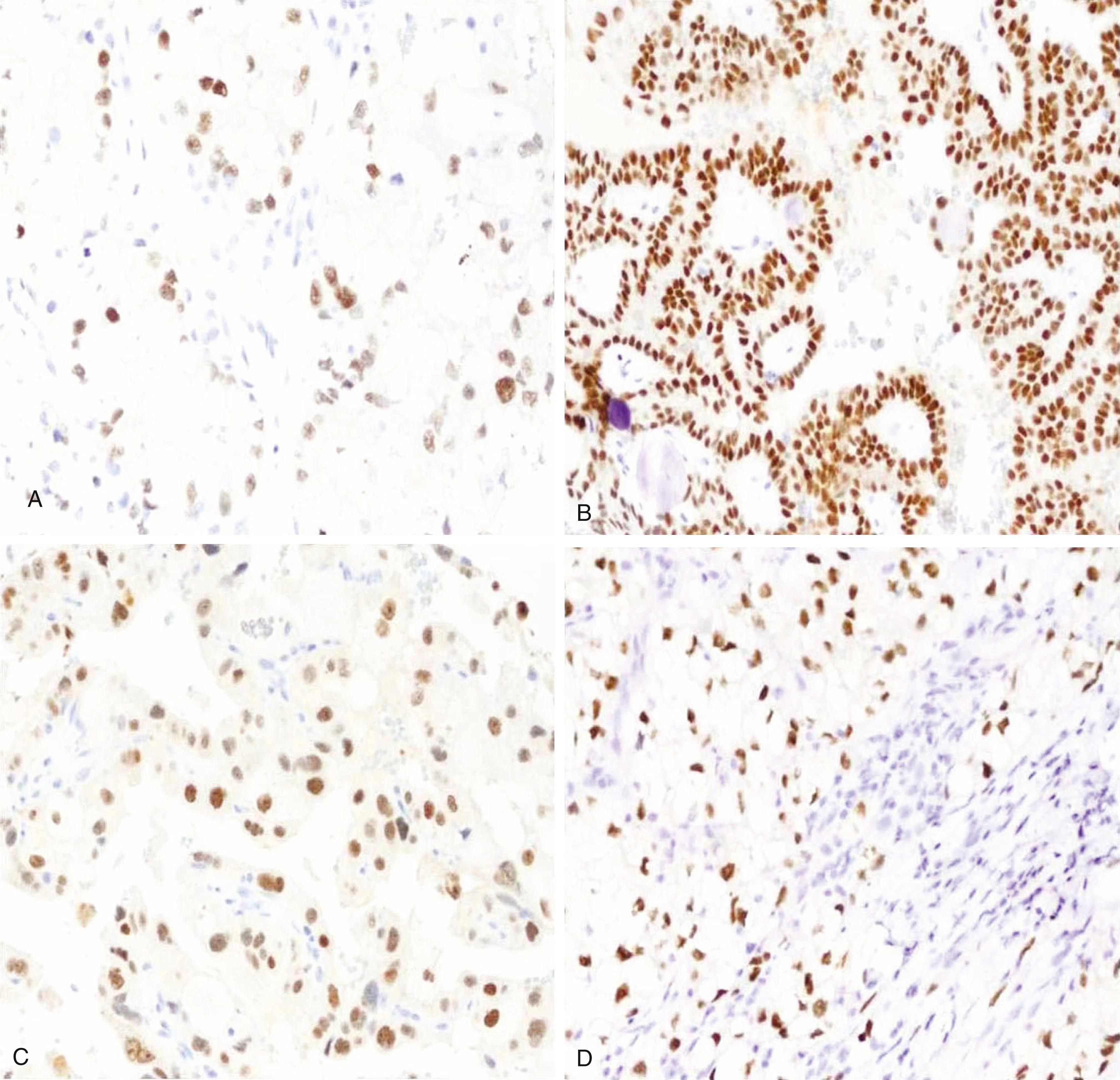
Epithelial cell-adhesion molecule (EpCAM)—also known as KSA, KS1/4, and 17-1 antigen—is a 34- to 40-kD glycosylated transmembrane cell-surface epithelial protein composed of 232 amino acids. EpCAM has gained interest as a potential therapeutic target because of its wide-spectrum expression in many epithelial malignancies. EpCAM is consistently expressed in the distal nephron in normal renal epithelium; CCRCC shows minimal and infrequent EpCAM expression. Almost half of PRCC are positive for EpCAM, whereas intense and frequent expression is the rule in ChRCC and collecting duct carcinoma. A study by Liu and associates confirmed the utility of EpCAM in differentiating eosinophilic variant of ChRCC from oncocytoma and CCRCC. EpCAM protein was expressed diffusely (>90% of cells) in all 22 cases of ChRCC analyzed, whereas less than one-third of oncocytomas displayed positivity for EpCAM, and only in single cells or small cell clusters of distribution. Combining EpCAM with other markers such as vimentin, glutathione S-transferase alpha (GST-α), CD117, and CK7 can be of utility in resolving the differential diagnosis of ChRCC. However, EpCAM is not recommended for routine use as single marker.
Cadherins are a large family of cell-to-cell adhesion molecules that act in a homotypic, homophilic manner and play an important role in the maintenance of tissue integrity. In the kidney, several members of the cadherin family—epithelial (E) and neuronal (N) cadherin and cadherins 6, 8, and 11—are expressed in a controlled spatiotemporal pattern. Cadherin-16, also referred to as kidney-specific cadherin (Ksp-cadherin), is exclusively expressed in epithelial cells of the adult kidney. In RCCs, a complex pattern of cadherin expression is observed.
In CCRCC, Thedieck and colleagues revealed loss of Ksp-cadherin. Subsequently the marker was proposed to be of help in differentiating ChRCC from oncocytoma. However, additional studies failed to confirm its utility with one study showing Ksp-cadherin mRNA and protein expression in approximately 80% of ChRCC and oncocytoma.
Carbonic anhydrase IX (CAIX) is an enzyme involved in maintaining intracellular and extracellular pH. In addition, CAIX plays a role in regulating cell proliferation, oncogenesis, and tumor progression. CAIX expression is von Hippel–Lindau (vHL)/HIF pathway dependent. In normal renal epithelium, expression of CAIX is suppressed by wild-type vHL protein. Given loss of vHL gene function in the majority of CCRCC tumors, CAIX antigen over-expression ensues. Most IHC studies have used clone M75 as the primary CAIX antibody to show diffuse over-expression in CCRCC. , CAIX expression has also been demonstrated in almost half of PRCC in a study by Gupta and colleagues, whereas other studies, including ours, revealed only rare PRCC staining ( Fig. 17.19A –C). Prognostically, low CAIX expression reportedly indicates poor survival and low response to interleukin therapy in CRCC. A commercially available antibody, clone NB100-417, was recently shown by Al-Ahmadie and associates to have a comparable expression profile. Although CAIX is of some utility in establishing a CCRCC origin of a metastatic carcinoma, it is not entirely specific.
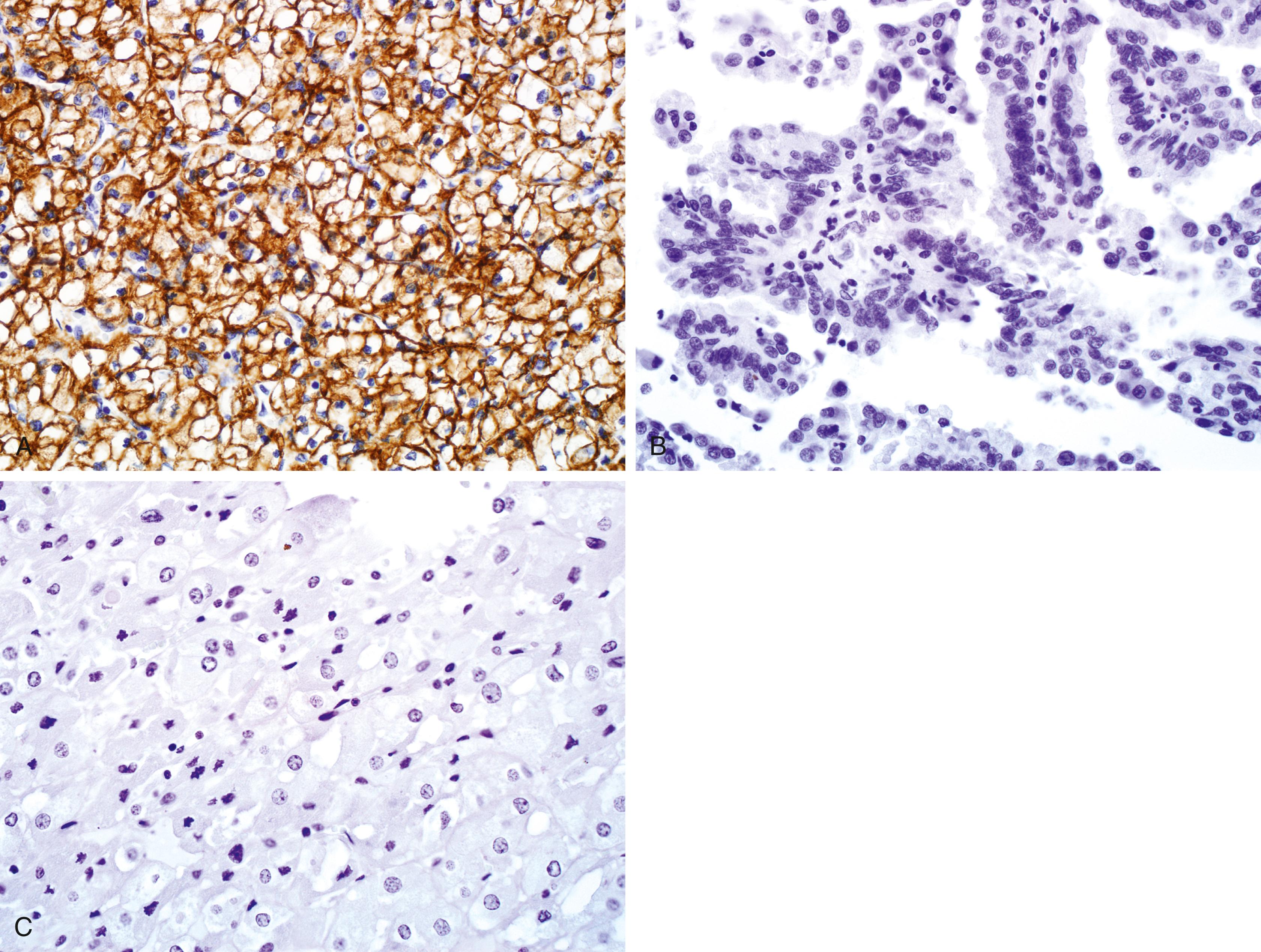
Glutathione S-transferase alpha (GST-α) protects cells by catalyzing the detoxification of xenobiotics and carcinogens. GST-α was found to be of possible diagnostic value in renal tumors. Based on cDNA microarray findings, IHC studies have so far shown GST-α to be highly expressed in CCRCC (90%), but not in ChRCC or oncocytomas, , and only occasionally in PRCC.
In the proper setting, utilizing of immunohistochemical markers improves the accuracy of classifying renal tumors, especially on needle biopsy. The use of IHC is justifiable in tumors with complex morphology (e.g., mixed papillary, clear cell, solid and or tubular patterns); when oncocytic, distal nephron, PEComa, MiTF family translocation carcinoma are in consideration; or in tumors occurring in young patients with possible familial risk syndromes. IHC and molecular testing are also required to establish the diagnosis of the ever-growing types of molecularly defined renal tumors (e.g., succinate dehydrogenase [SDH] deficient, fumarate hydratase [FH] deficient, ALK fusion).
Both extent and pattern of immunostaining must be considered for a definitive diagnosis, and IHC results should always be integrated with the overall morphologic features. There is no perfect antibody, and unexpected staining results reflects the limits of specificity and sensitive of each of the above markers. The reader is referred to more detailed discussions on the role of IHC in seminal opinion manuscripts published by the ISUP and GUPS urologic societies.
Oncocytomas are benign renal neoplasms typically characterized grossly by a mahogany-brown color. Microscopically, the tumor is composed of islands of “oncocytic” cells with coarsely granular eosinophilic cytoplasm set in a typical edematous, myxoid, focally hyalinized stroma. Oncocytomas display round, vesicular, centrally located nuclei with conspicuous nucleoli and occasional marked nuclear polymorphism. A range of architectural features is encountered that includes nested, tubular, acinar, cystic, and solid patterns. Areas of necrosis are not seen, with the exception of commonly observed central degenerative ischemic change. The diagnosis of oncocytoma should be called into question if an “oncocytic” tumor reveals papillary architecture or areas of bona fide optically clear cytoplasm. An oncoblastic pattern is well recognized in some oncocytomas, in which the tumor cells become smaller in size with increased nuclear/cytoplasmic ratio; the latter does not carry any significant prognostic connotation. , A cautionary note is warranted when making a diagnosis of oncocytoma on limited material because other types of renal neoplasms—such as PRCC, ChRCC, and CCRCC—can display focal “oncocytic” areas that share the eosinophilic granular cytoplasmic appearance of oncocytoma.
Immunohistochemically, oncocytomas are positive for pancytokeratin AE1/AE3, and low-molecular-weight cytokeratin (LMWCK) CAM5.2 and are negative for vimentin. c-Kit (CD117) expression is encountered in more than two-thirds of oncocytomas, a feature also shared by ChRCC. , , As mentioned above, Ksp-cadherin is also expressed in the majority of oncocytomas and ChRCC. Unlike the usually diffuse CK7 staining seen in chromophobe RCC, oncocytomas are typically negative or patchy for CK7. Oncocytoma is usually negative for RCC and only occasionally expresses CD10. Commonly encountered cytogenetic findings in oncocytomas include loss of chromosome Y and chromosome 1.
Positive: Hale colloidal iron stain, in perinuclear location; CK7, EpCAM (in addition to CD117 and Ksp-cadherin)
Negative: Complete loss of SDHB (weak diffuse/cytoplasmic blush relative to darker granular-mitochondrial staining in internal control cells also qualifies as loss); CD117, CK7 (can be weak-focal)
Positive: HMB45, Melan-A, Actin, Vimentin
Negative: CD117, CK7, PAX8
Metanephric adenoma of the kidney is a unique form of renal adenoma characterized by a proliferation of tubular and micropapillary to glomeruloid structures lined by bland cuboidal epithelial cells. The relatively high nuclear/cytoplasmic ratio of metanephric adenoma cells and their slightly amphophilic cytoplasmic coloration impart a typical “blue” low-power appearance to the neoplastic nodule. The latter is in contrast to the lighter eosinophilic appearance of its main differential diagnosis, the solid variant of PRCC. Like PRCC, metanephric adenoma can feature foamy histiocytes in papillary cores and occasional psammomatous calcifications. Helpful IHC features of the tumor are its positivity for Wilms tumor 1 (WT1) and CD57, and negative staining for epithelial membrane antigen (EMA), CK7, AMACR, a profile that contrasts with that of solid PRCC. Some authors have recommended that all adult cases histologically resembling metanephric adenoma should have immunohistochemical staining performed. If the staining pattern is characteristic for metanephric adenoma (CK7−, AMACR−, WT1+, and CD57+, including membranous staining), then no other diagnostic tests are indicated. However, if there is a different immunostaining pattern, then FISH analysis to rule out solid variant of PRCC may be warranted ( Fig. 17.20A –D). In this regard, the frequent presence (over 90%) of BRAF V600E mutations in metanephric adenoma could also be exploited in establishing the diagnosis.
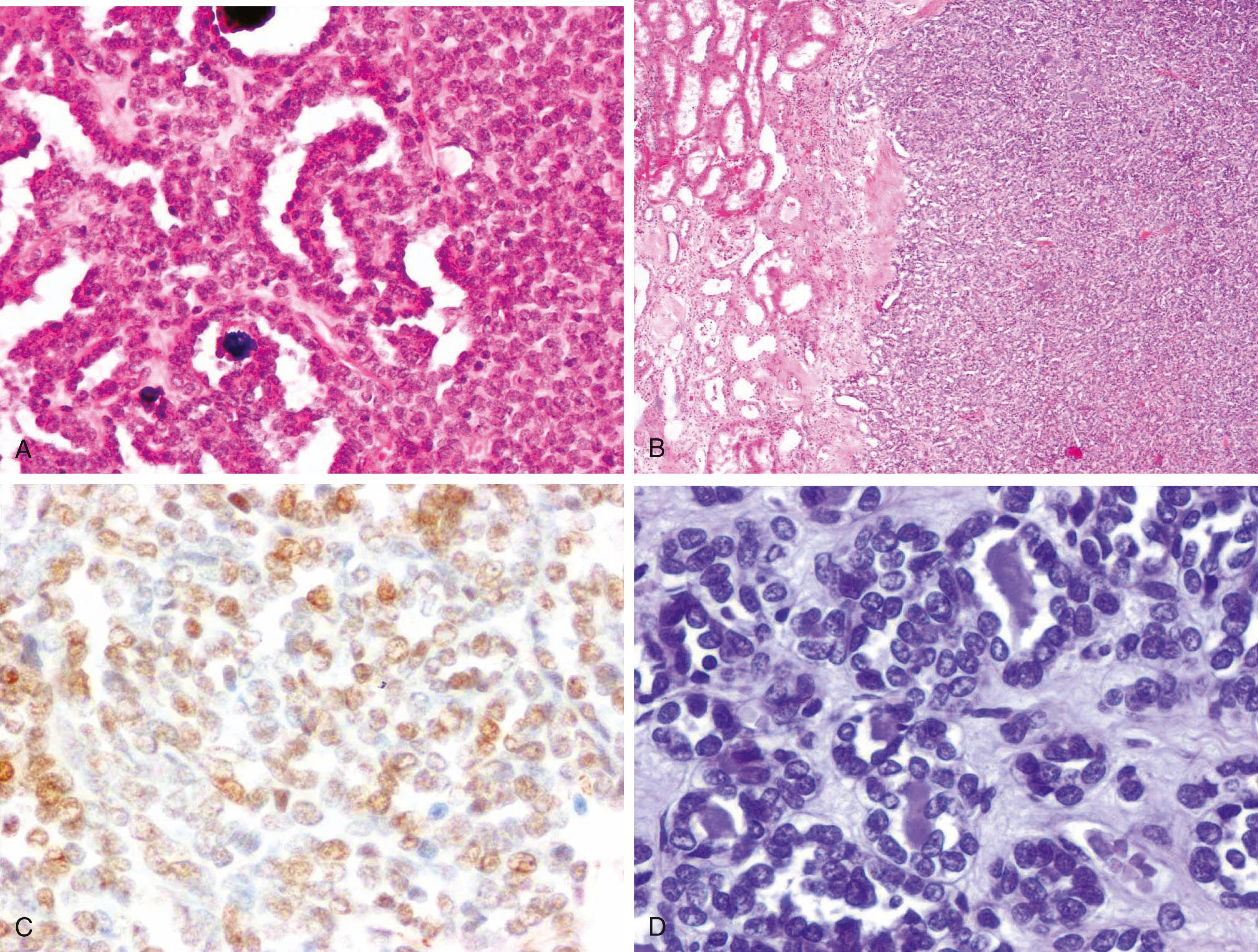
CCRCC is the most common type of RCC and accounts for 70% to 80% of tumors. Microscopically, CCRCC is composed of cuboidal cells with typical optically cleared cytoplasm arranged in nests, tubules, and acini. CCRCC are richly vascularized tumors, with delicate branching vasculature (chicken wire-like pattern) and areas of hemorrhage that impart a “bleeding acini” characteristic morphology. CCRCC can display areas of eosinophilic granular cytoplasm that usually are of higher nucleolar grade. As discussed later, at the genetic level, similar to their familial counterpart, almost two-thirds of sporadic CCRCC demonstrate partial or complete chromosome 3 loss (or mutation), resulting in the loss of the VHL tumor suppressor gene, located at 3p25–26. , Chromosome 3p deletion simultaneously can lead to loss of other tumor suppressor genes such as PBRM 1 , SETD2 , and BAP1 . The Key Diagnostic Points box at the end of this section summarizes the IHC profile of CCRCC. , , ,
CCRCC is usually positive for CAM5.2 and CKs AE1/AE3 but is almost always negative for CK7 and CK20. It is positive for EMA and vimentin. , CCRCC’s negative reactivity for HMWCKs such as cytokeratin CK5/6 and 34βE12 (keratin 903) and for p63 and GATA3 is a useful feature in the differential against upper urinary tract UC, which is regularly HMWCK and p63 positive. ,
One should remember that the range of CCRCC reactivity with the previous markers varies among studies, making it necessary to exercise a judicial interpretation of any IHC panel when classifying a renal tumor. , In one study from the MSKCC group addressing the utility of IHC in needle biopsies of renal masses, the extent and pattern of immunoexpression were highly useful in the diagnoses: diffuse, membranous CAIX expression was noted in CCRCC, diffuse positivity for α-methylacyl–Coenzyme-A racemase (AMACR) in PRCC, distinct peripheral cytoplasmic accentuation for CD117 in ChRCC, widespread and intense positivity for CK7 in ChRCC and PRCC, diffuse membranous reactivity in CCRCC, and patchy/luminal staining in PRCC for CD10.
Become a Clinical Tree membership for Full access and enjoy Unlimited articles
If you are a member. Log in here